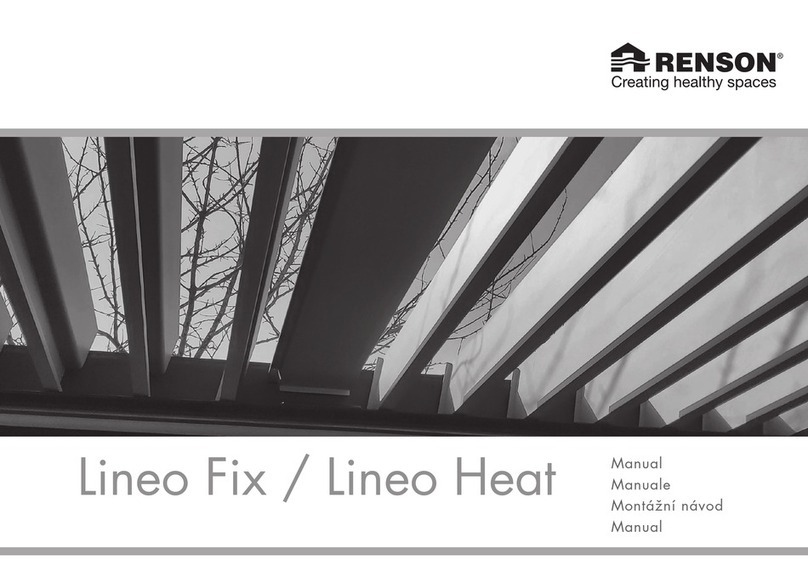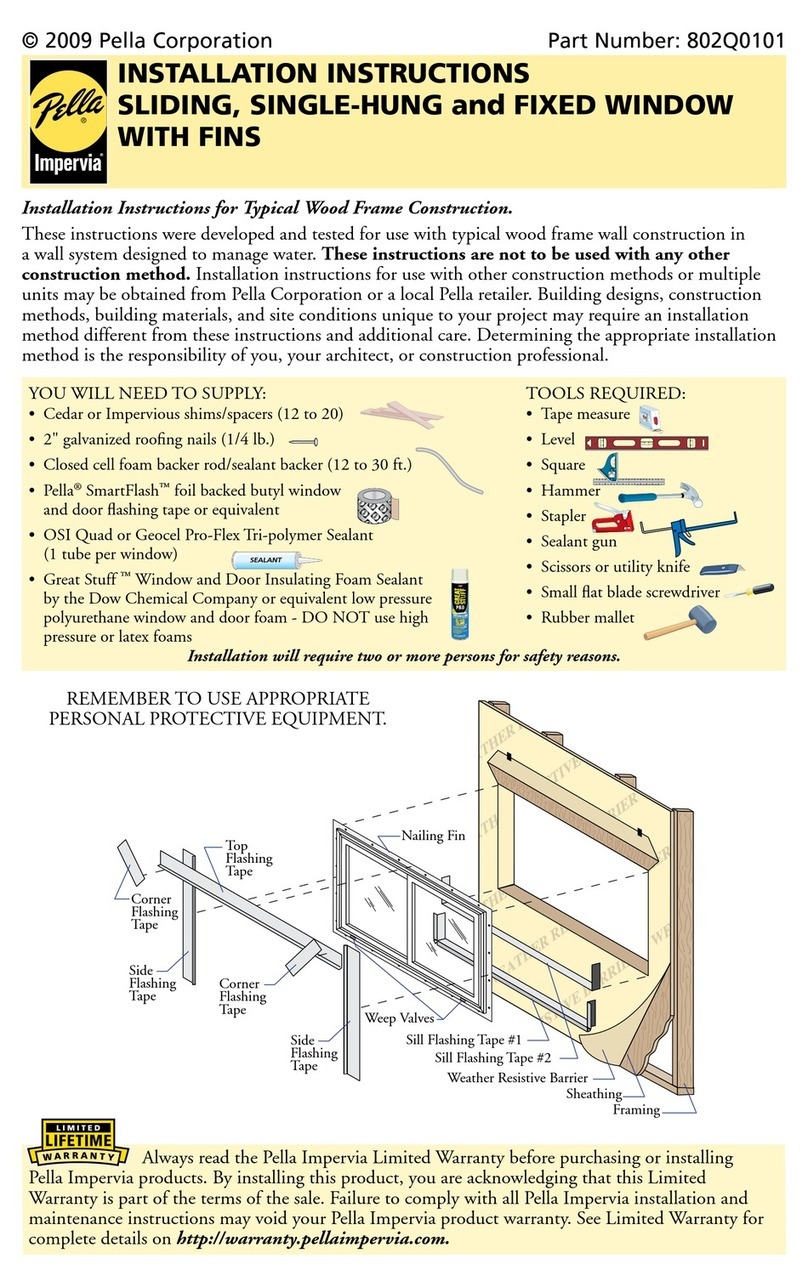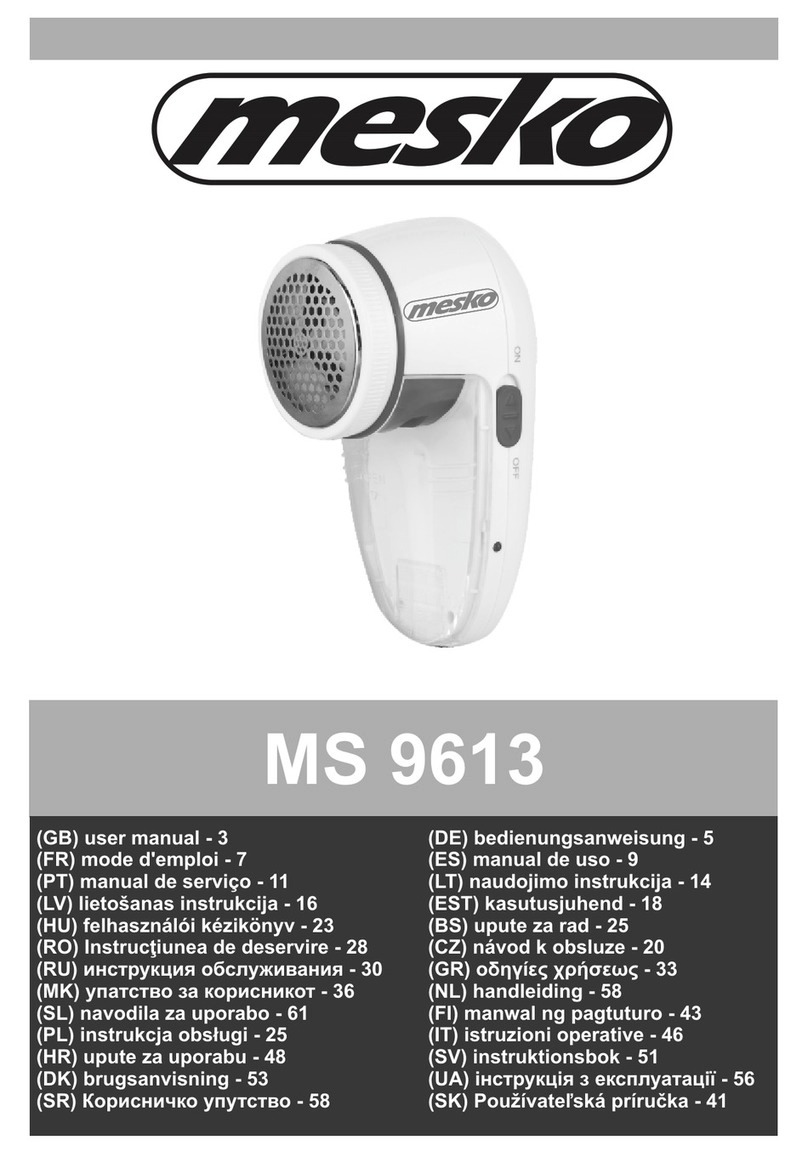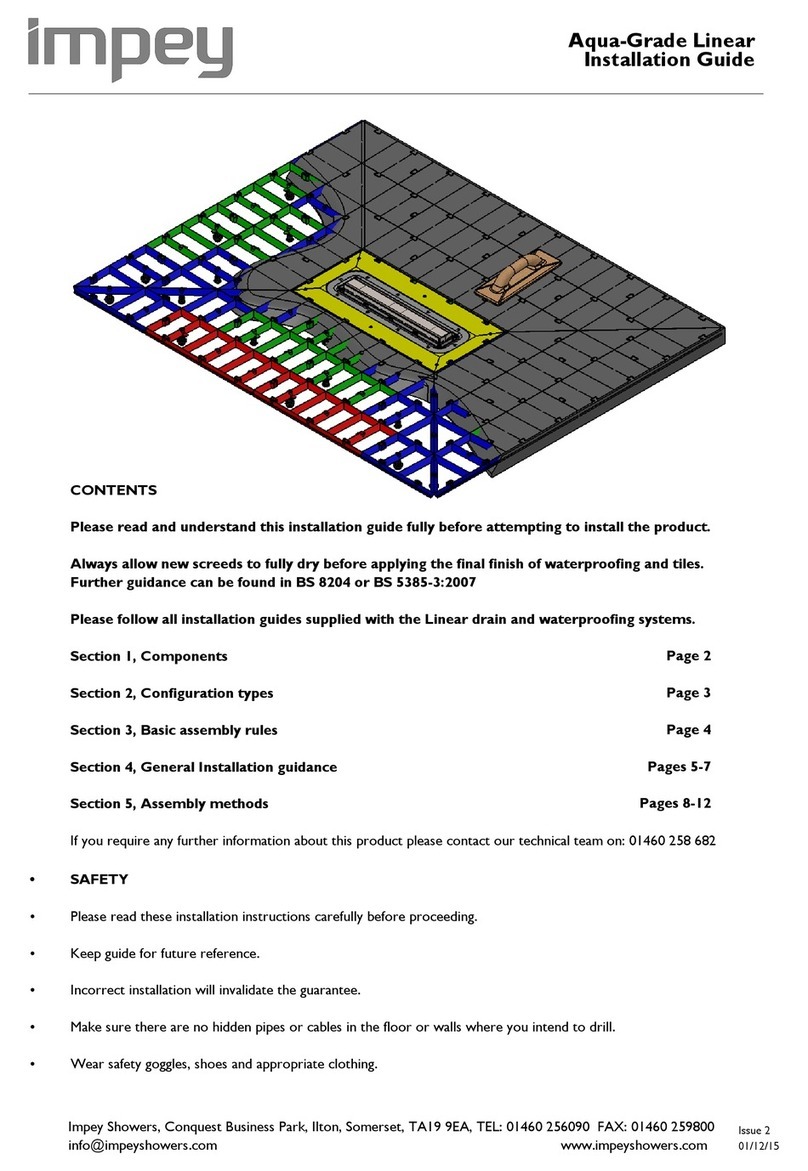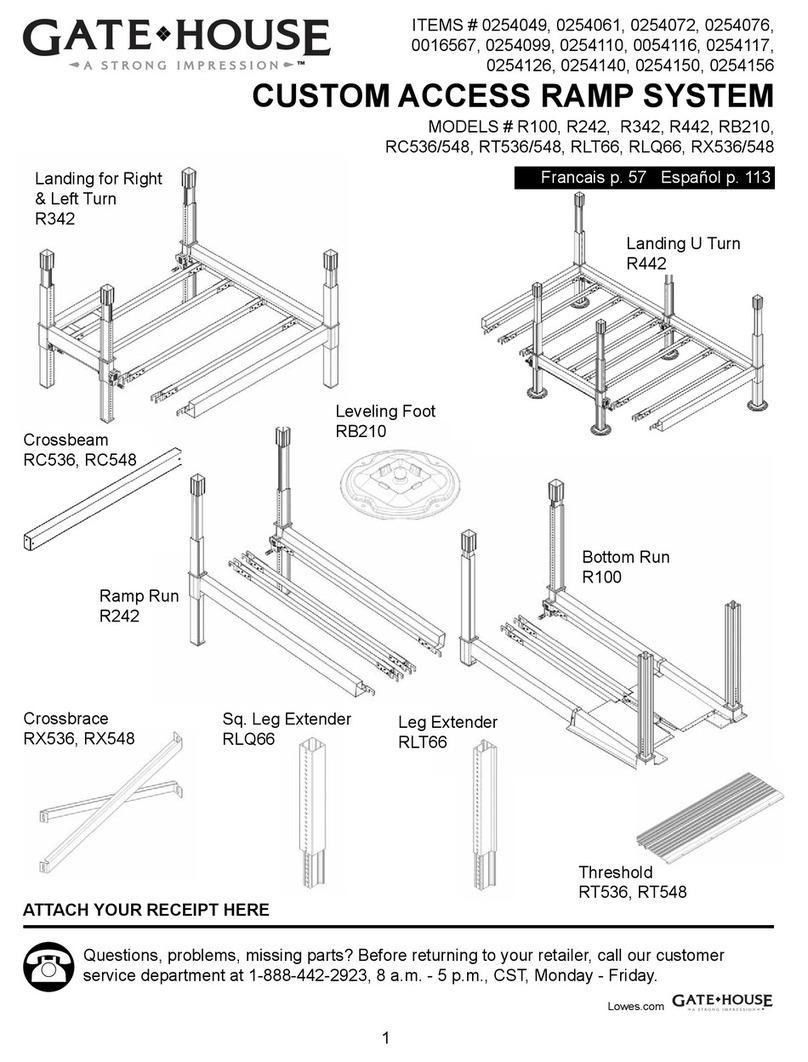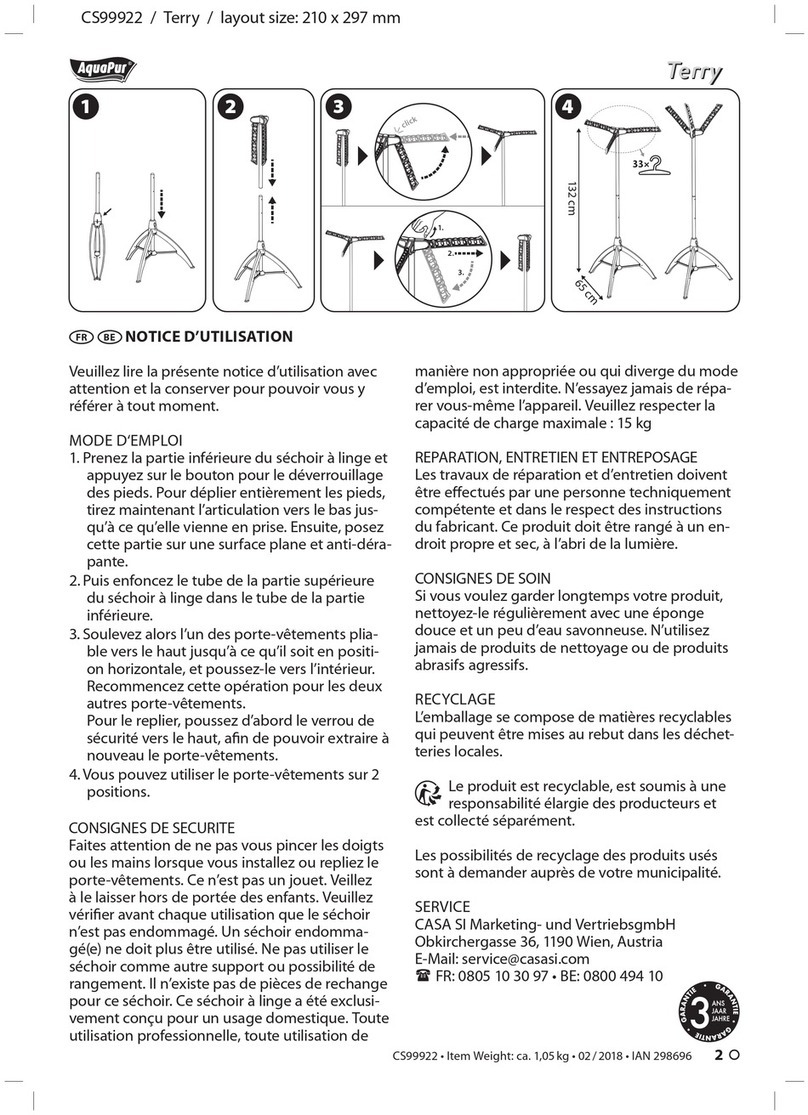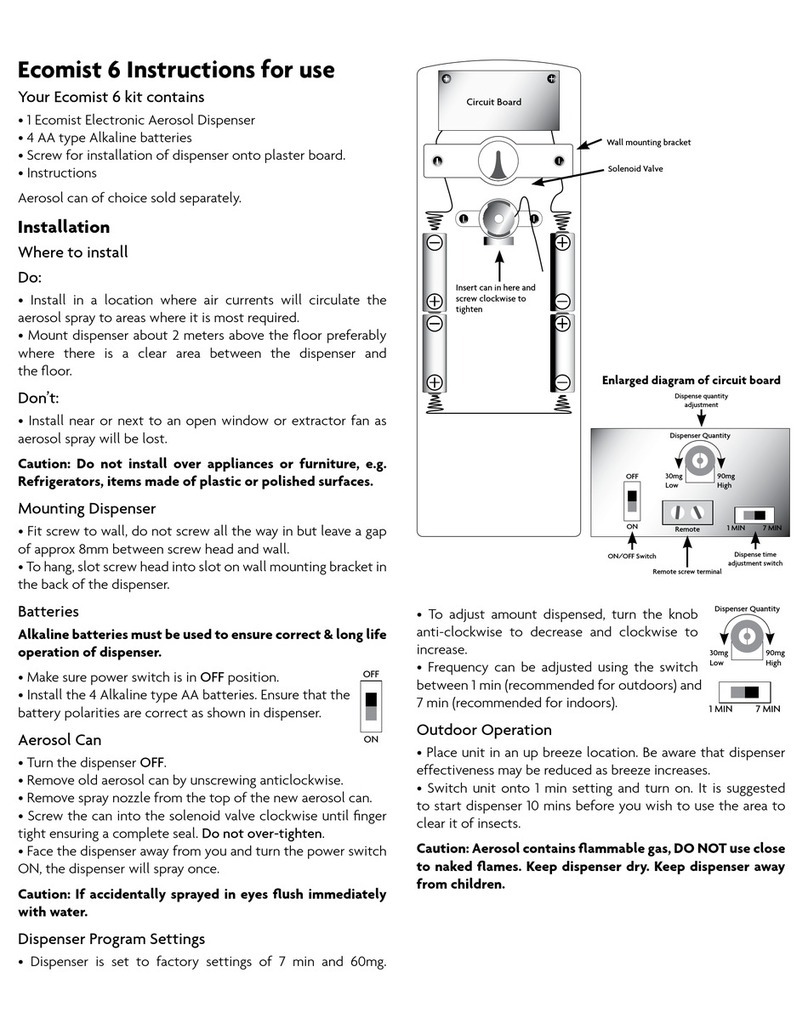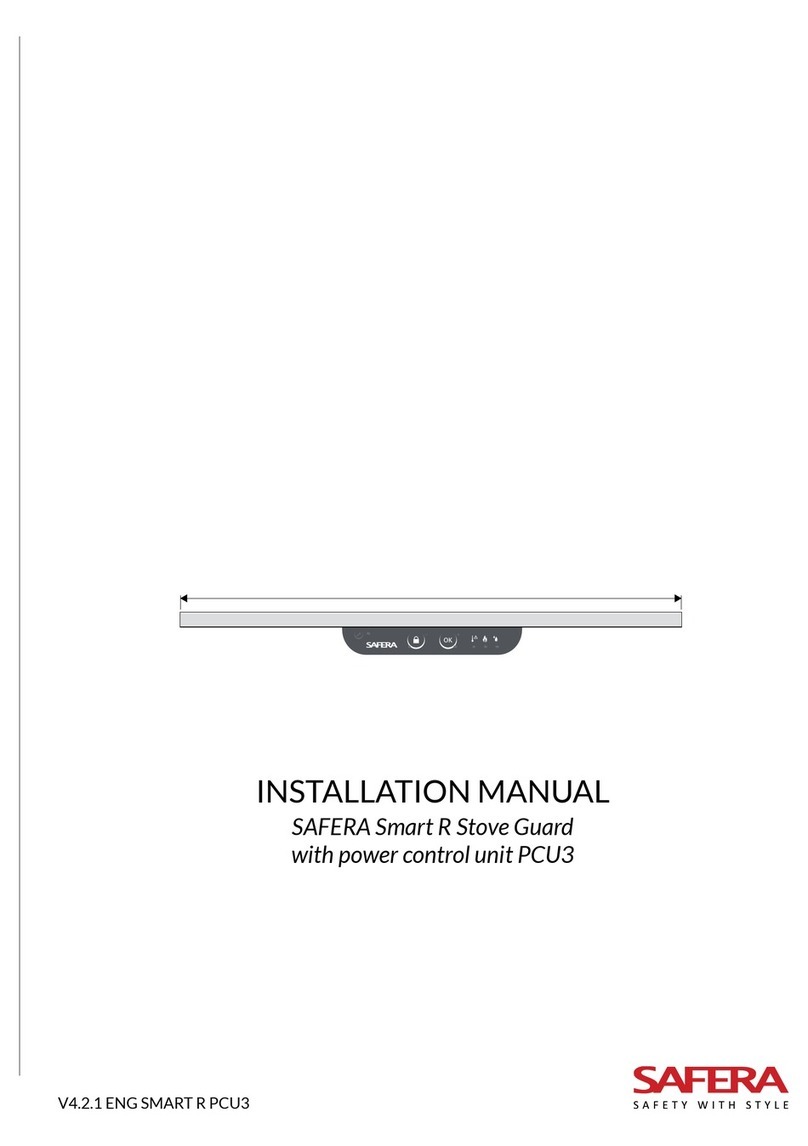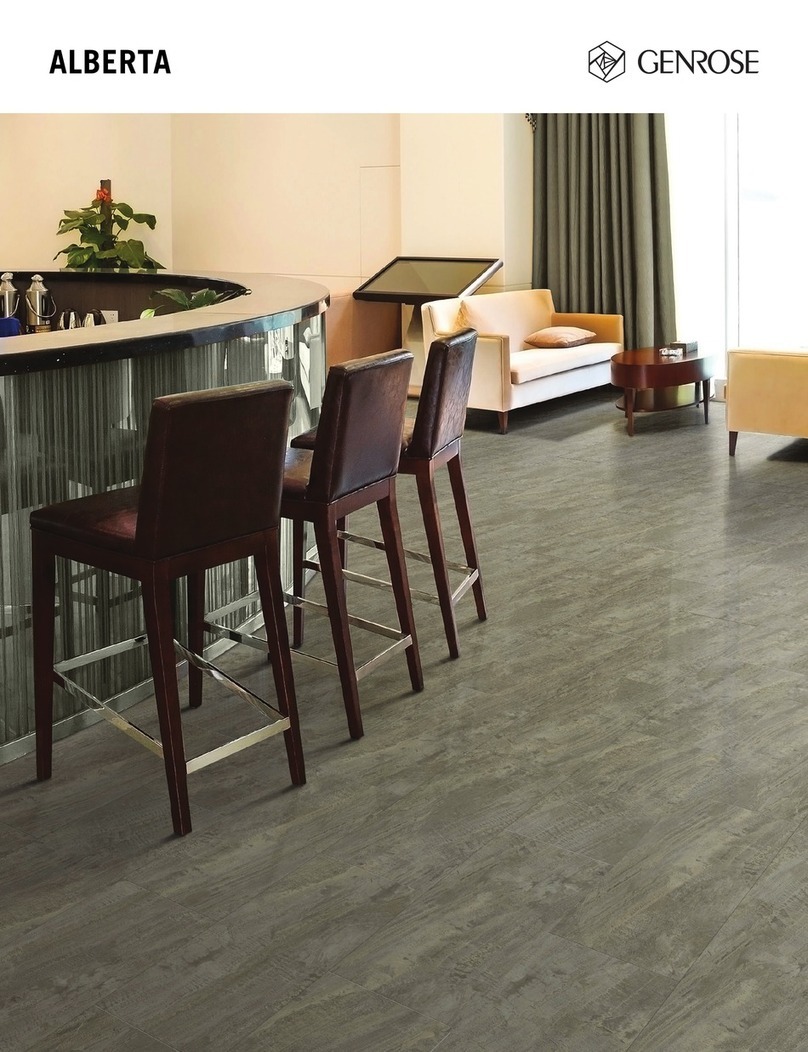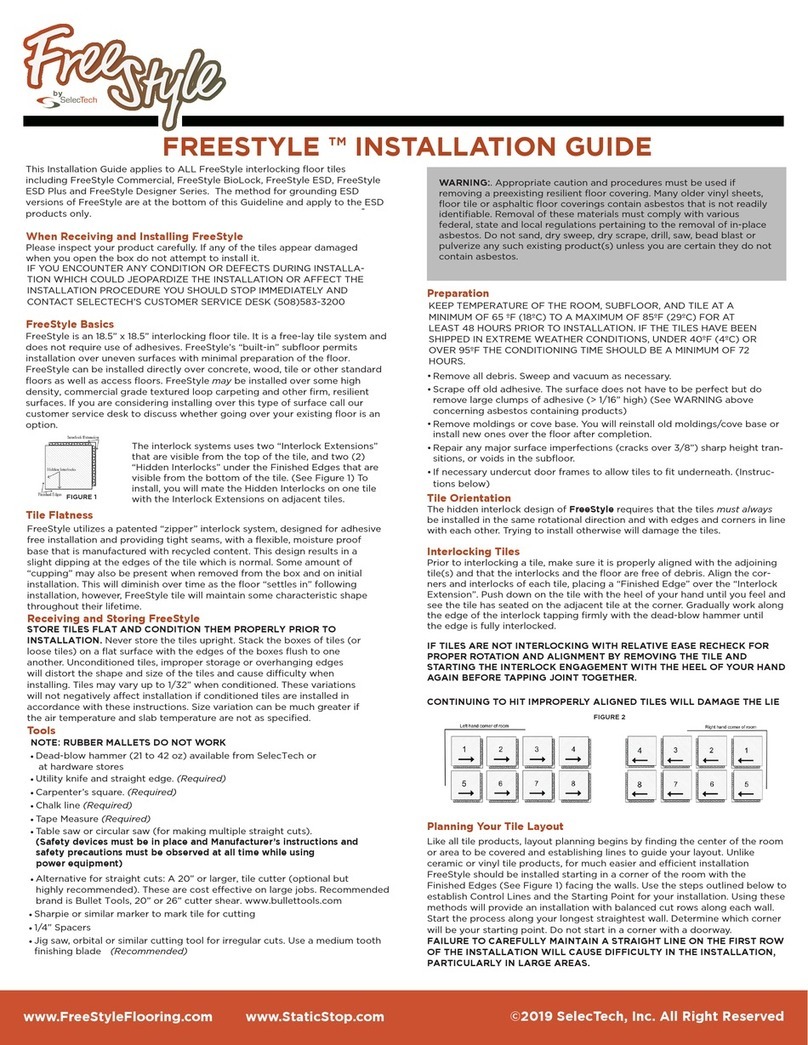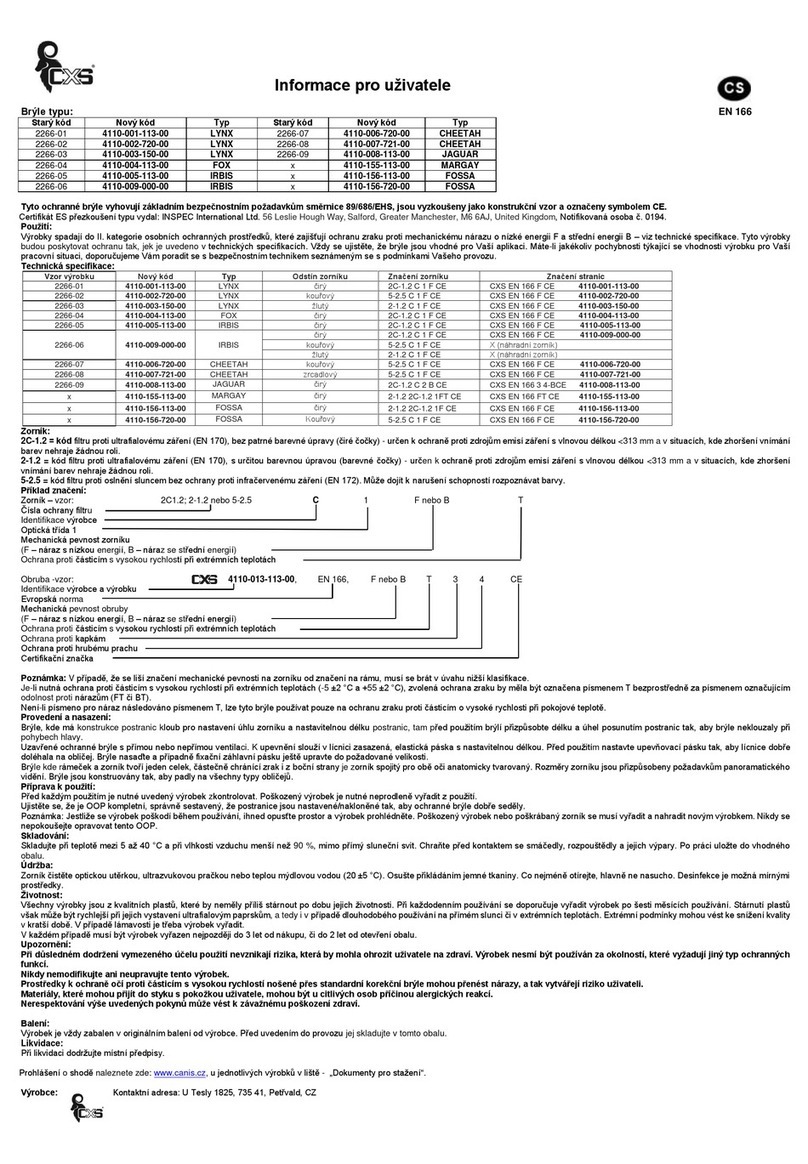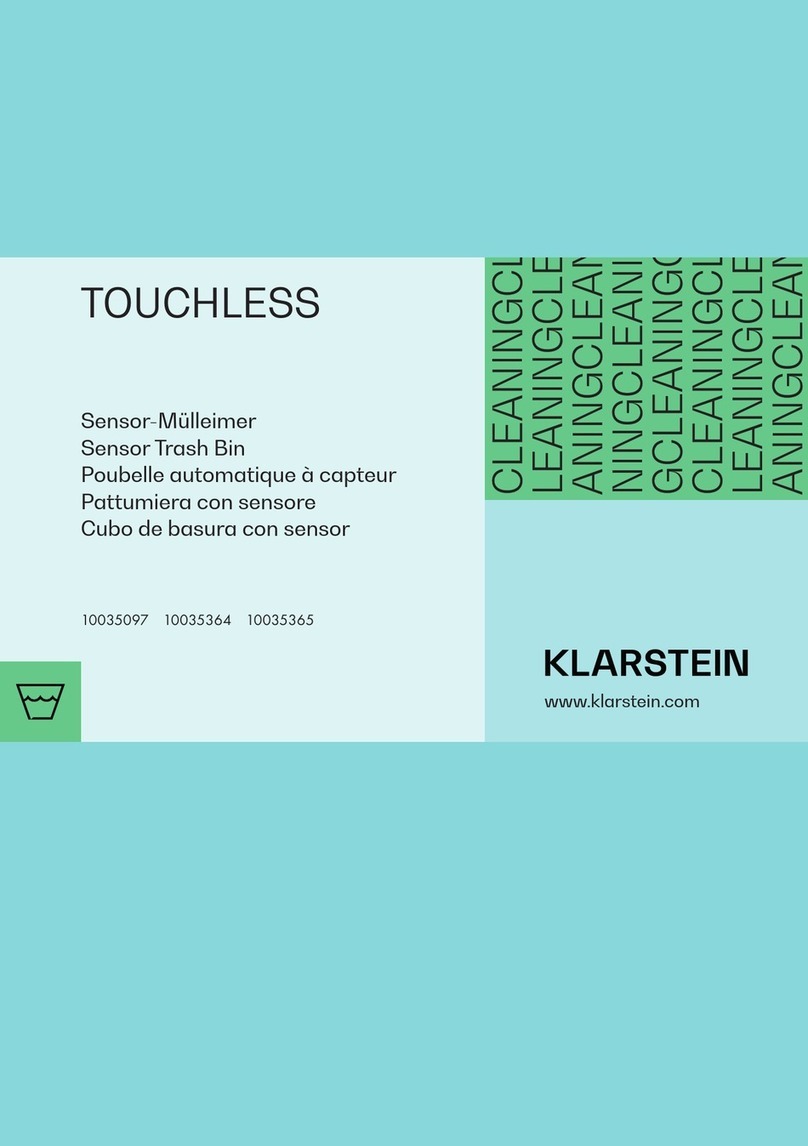Renson Linarte User manual

Handleiding
Notice de montage
Montageanleitung
Manual
Linarte

Linarte
2
TABLE OF CONTENTS
Application guidelines 7
1. Types of profiles and clips 8
2. Construction of the underlying structure 10
2.1 Fixation to beams 10
2.2 Direct fixation 12
3. Example of a Linarte façade cladding
over several walls 14
4. Explanation of a wall drawing 16
4.1 Front view 16
4.2 Top view 16
4.3 Parts list per section 18
4.4 Detail of beginning and end of
the wall 20
4.5 Detail left and right of each
opening 26
5. Construction of the Linarte façade
cladding on a wooden structure 28
5.1 Installation of the support profile 28
5.2 Installation of the mullions 30
5.3 Choice of clips 32
5.4 Installation of the clips 34
5.5 Installation of the profiles 36
5.6 Installation of the mullion on an
outside corner 40
5.7 Installation of the clips on an
outside corner 42
5.8 Installation of the corner profiles
on an outside corner 44
5.9 Installation of the mullion on an
inside corner 48
5.10 Installation of the clips on an
inside corner 50
5.11 Installation of the corner profiles
on an inside corner 52
5.12 Installation and use of the
changing profile 56
6. Surface mounting Linarte façade
cladding with direct fixation (option) 58
6.1 Installing the support profile and
lowermost support 58
6.2 Installing the other supports 62
6.3 Installing supports and support
profiles on an outer corner 66
7. Window reveal finishes (option) 68
INHALTSANGABE
Anwendungsrichtlinien 6
1. Typen von Profilen und Clipsen 8
2. Aufbau der dahinterliegenden Struktur 10
2.1 Befestigung auf Sparren 10
2.2 Direkte Befestigung 12
3. Beispiel einer Linarte-Fassaden-
verkleidung über mehrere Wände 14
4. Erläuterung einer Wandzeichnung 16
4.1 Vorderansicht (Front view) 16
4.2 Draufsicht (Top view) 16
4.3 Stückliste pro Abschnitt 18
4.4 Detail Anfang und Ende der
Wand 20
4.5 Detail links und rechts von jeder
Öffnung 26
5. Aufbau der Linarte-Fassadenverkleidung
an einer Holzkonstruktion 28
5.1 Montage des Stützprofils 28
5.2 Montage der Träger 30
5.3 Wahl der Clipse 32
5.4 Montage der Clipse 34
5.5 Montage der Profile 36
5.6 Montage des Trägers auf einer
Außenecke 40
5.7 Montage der Clipse auf einer
Außenecke 42
5.8 Montage der Eckprofile an einer
Außenecke 44
5.9 Montage des Trägers an einer
Innenecke 48
5.10 Montage der Clipse an einer
Innenecke 50
5.11 Montage der Eckprofile an einer
Innenecke 52
5.12 Montage und Verwendung des
Wechselprofils 56
6. Konstruktion der Linarte Fassaden-
verkleidung, direkte Befestigung
(Option) 58
6.1 Montage des Stützprofils und
des untersten Trägers 58
6.2 Platzierung der anderen Träger 62
6.3 Montage der Stützprofile und
Träger auf einer Außenecke 66
7. Laibungsabschluss Fenster (Option) 68
TABLE DES MATIERES
Instructions d’application 5
1. Sortes de profils et de clips 8
2. Construction de la structure sous-jacente 10
2.1 Fixation sur ossature en bois 10
2.2 Fixation directe 12
3. Exemple d’un revêtement de façade
Linarte avec plusieurs murs 14
4. Explication d’un dessin de mur 16
4.1 Vue avant (Front view) 16
4.2 Vue de dessus (Top view) 16
4.3 Liste de pièces par section 18
4.4 Détail du début et de la fin d’un
mur 20
4.5 Détail à gauche et à droite de
chaque ouverture 26
5. Construction du revêtement de façade
Linarte sur ossature en bois 28
5.1 Installation du profil de support 28
5.2 Installation des porteurs 30
5.3 Choix des clips 32
5.4 Installation des clips 34
5.5 Installation des profils 36
5.6 Installation du porteur sur un
angle extérieur 40
5.7 Installation des clips sur un angle
extérieur 42
5.8 Installation des profils d’angle
sur un angle extérieur 44
5.9 Installation du porteur sur un
angle intérieur 48
5.10 Installation des clips sur un angle
intérieur 50
5.11 Installation des profils d’angle
sur un angle intérieur 52
5.12 Installation et utilisation du profil
d’échange 56
6. Construction du revêtement de façade
Linarte avec fixation directe (option) 58
6.1 Pose du profil de support et du
porteur inférieur 58
6.2 Pose des autres porteurs 62
6.3 Pose des profils de support et les
porteurs sur un angle extérieur 66
7. Finition des ébrasements de fenêtres
(option) 68
INHOUDSTAFEL
Toepassingsrichtlijnen 4
1. Soorten profielen en clipsen 8
2. Opbouw van de achterliggende
structuur 10
2.1 Bevestiging op keperwerk 10
2.2 Directe bevestiging 12
3. Voorbeeld van een Linarte gevel-
bekleding over meerdere wanden 14
4. Toelichting van een wandtekening 16
4.1 Vooraanzicht (Front view) 16
4.2 Bovenaanzicht (Top view) 16
4.3 Stuklijst per sectie 18
4.4 Detail begin en einde van de
wand 20
4.5 Detail links en rechts van elke
opening 26
5. Opbouw van de Linarte gevelbekleding
op keperwerk 28
5.1 Plaatsen van het steunprofiel 28
5.2 Plaatsen van de dragers 30
5.3 Keuze van de clipsen 32
5.4 Plaatsen van de clipsen 34
5.5 Plaatsen van de profielen 36
5.6 Plaatsen van de drager op een
buitenhoek 40
5.7 Plaatsen van de clipsen op een
buitenhoek 42
5.8 Plaatsen van de hoekprofielen
op een buitenhoek 44
5.9 Plaatsen van de drager op een
binnenhoek 48
5.10 Plaatsen van de clipsen op een
binnenhoek 50
5.11 Plaatsen van de hoekprofielen
op een binnenhoek 52
5.12 Plaatsen en gebruik van het
wisselprofiel 56
6. Opbouw van de Linarte gevelbekleding
directe bevestiging (optie) 58
6.1 Plaatsen van het steunprofiel en
onderste drager 58
6.2 Plaatsen van de andere dragers 62
6.3 Plaatsen van de steunprofielen en
de dragers op een buitenhoek 66
7. Dagkantafwerkingen ramen (optie) 68

Linarte
3
RENSON®LINARTE
First read this manual carefully before you
begin. The installation of the RENSON®
Linarte should be done by a specialist.
RENSON®reserves the right to make tech-
nical changes to its products without prior
notice.
8. Finishes (option) 74
8.1 Mounting the door handle 74
8.2 Door bottom finish 76
8.3 Door bottom finish 76
8.4 Finish next to door 78
8.5 Door top finish 80
8.6 Door top finish 80
9. Installing a profile finger-clamp sensor
(option) 82
10. Installation of fire resistant clips
(option) 84
11. LED modules 86
11.1 Installation of a LED module 86
11.2 Connecting an LED module with
dimmable IO control 90
11.3 Connecting an LED module with
non-dimmable IO control 90
11.4 Connecting an LED module RTS
control 92
12. Installation of indirect lighting (option) 96
12.1 Mounting the LED strips 96
12.2 Connecting the LED strips 96
12.3 Mounting the transformer 98
13. Fitting a wood insert 100
14. Installing the techniques 104
RENSON®LINARTE
Lisez attentivement ce manuel avant de
commencer. L’installation du Linarte de
RENSON®doit être effectuée par un profes-
sionnel.
RENSON®se réserve le droit d’apporter des
modifications techniques à ses produits sans
avis préalable.
8. Finitions (option) 74
8.1 Montage du tirant de porte 74
8.2 Finition au bas pour une porte 76
8.3 Finition au bas de porte/
de chaque panneau de porte 76
8.4 Finition à côté de la porte/
porte sectionnelle 78
8.5 Finition en haut pour une porte 80
8.6 Finition en haut pour un portail 80
9. Pose d’un profil de capteur
anti-pincement (option) 82
10. Pose de clips résistant au feu (option) 84
11. Modules LED 86
11.1 Installation d’un module LED 86
11.2 Raccordement d’un module LED -
commande io gradable 90
11.3 Raccordement d’un module LED -
commande io non gradable 90
11.4 Raccordement d’un module LED
commande RTS 92
12. Installation de l’éclairage indirect
(option) 96
12.1 Montage de la bande de LED 96
12.2 Connexion de la bande de LED 96
12.3 Montage du transformateur 98
13. Installation d’un insert en bois 100
14. Installation de techniques 104
RENSON®LINARTE
Lesen Sie diese Montageanleitung aufmerk-
sam durch, bevor Sie mit der Montage begin-
nen. Die Montage von RENSON®Linarte
muss durch einen Fachmann erfolgen.
RENSON®behält sich das Recht vor, ohne
vorherige Mitteilung technische Änderungen
seiner Produkte vorzunehmen.
8. Abschlüsse (Option) 74
8.1 Montage des Türgriffs 74
8.2 Abschluss an der Unterseite einer
Tür 76
8.3 Abschluss Unterseite am Tor/
an jedem Torflügel 76
8.4 Abschluss neben Tür/Tor 78
8.5 Abschluss an der Oberseite
einer Tür 80
8.6 Abschluss an der Oberseite
eines Tors 80
9. Anbringen des Profils des Fingerklemm-
sensors (Option) 82
10. Montage von Brandschutzklipsen
(Option) 84
11. LED-Module 86
11.1 Montage eines LED-moduls 86
11.2 Anschluss eines LED-Moduls -
dimmbare IO-Bedienung 90
11.3 Anschluss eines LED-Moduls -
nicht-dimmbare IO-Bedienung 90
11.4 Anschluss eines LED-Moduls
RTS-Bedienung 92
12. Indirekte Beleuchtung installieren
(Option) 96
12.1 Montage der LED-Streifen 96
12.2 LED-Streifen anschließen 96
12.3 Trafomontage 98
13. Montage einer Holzfüllung 100
14. Montage der Techniken 104
RENSON®LINARTE
Lees deze handleiding eerst aandachtig
eer u van start gaat. Het plaatsen van de
RENSON®Linarte dient te gebeuren door
een vakman.
RENSON®behoudt zich het recht voor om
zonder voorafgaande kennisgeving techni-
sche wijzigingen aan haar producten aan te
brengen.
8. Afwerkingen (optie) 74
8.1 Monteren deurtrekker 74
8.2 Afwerking onderaan bij een
deur 76
8.3 Afwerking onderaan bij poort/
ieder poortpaneel 76
8.4 Afwerking naast deur/poort 78
8.5 Afwerking bovenaan bij een
deur 80
8.6 Afwerking bovenaan bij een
poort 80
9. Plaatsen van profiel vingerklemsensor
(optie) 82
10. Plaatsen van brandveilige clipsen
(optie) 84
11. LED-modules 86
11.1 Monteren van een LED-module 86
11.2 Aansluiten van een LED-module -
dimbaar io bediening 90
11.3 Aansluiten van een LED-module -
niet dimbaar io bediening 90
11.4 Aansluiten van een LED-module
RTS bediening 92
12. Plaatsen van indirecte verlichting (optie) 96
12.1 Monteren van de LED-strips 96
12.2 Aansluiten van de LED strips 96
12.3 Monteren van de transfo 98
13. Plaatsen van een houtinvulling 100
14. Plaatsen van technieken 104

Linarte
4
Voor België en Nederland komt dit neer op
een maximale plaatsingshoogte Hpmax in
functie van de windzone en de terreincate-
gorie, zoals in onderstaande tabellen weer-
gegeven.
Plaatsing op minder dan 5 km van de kustlijn
is met deze configuraties niet toegestaan.
Ons systeem is geschikt voor deze windlas-
ten, maar zorg ervoor dat de achterliggende
structuur hier ook tegen bestand is.
EN 1991-1-4 (1995)
4. Mechanische stabiliteit
enwindwerking
Alle standaard configuraties zijn geschikt
voor toepassing op locaties waar de extreme
stuwdruk qp, zoals bepaald in EN 1991-1-4
(1995), lager is dan 0,8 kN/m2.
Het bepalen van de tussen en bevestigingsaf-
standen moet voor elk project gebeuren door
een studiebureau, rekening houdende met:
• Windbelasting volgens EN 1991-1-4
• Vaststellen van de fundamentele basiswind-
snelheid
• Vaststellen van de terrein categorie
• Vaststellen van de gebouwhoogte
• Gekozen bevestigingsmiddel
• Massa van de wand
• Materiaal van de achterliggende dragende
structuur
• Uitkraging van het systeem.
ongedierte. Dit profiel wordt geklemd tussen
de houten draaglat en de gevelbekleding en
de dikte mag niet meer dan 1 mm bedragen.
De som van de perforaties zichtbaar in de
voeg moet minstens 100 cm²/m bedragen.
3. Houten draagstructuur
Bij de Linarte gevelbekleding worden de
draaglatten op een bepaalde afstand op
een verticale achter constructie bevestigd met
behulp van x aantal afstandsmontageschroe-
ven, beschikbaar bij gespecialiseerde veran-
keringsproducenten/verdelers.
De plaatsing van de draagstructuur aan de
hand van afstandsmontageschroeven dient
te gebeuren volgens de richtlijnen en de
garantievoorwaarden van de leverancier
van de schroeven. Voor specifiek advies kan
u terecht bij een gespecialiseerd bedrijf.
Om de bestendigheid van het bouwwerk te
verzekeren, moet de houten draagstructuur
een toereikende duurzaamheid vertonen.
Het hout dat wordt toegepast voor de achter
constructie dient te voldoen aan de voor-
waarden volgens EN 350 – 1 en EN 350 – 2
en verduurzaamd volgens de geldende norm
EN 335.
Voor specifiek advies kan u terecht bij een
gespecialiseerd bedrijf.
TOEPASSINGSRICHTLIJNEN
1. Algemeen
Deze toepassingsrichtlijnen zijn specifiek
bedoeld voor de bevestiging van de Linarte
gevelbekleding op een geventileerde en
geïsoleerde draagstructuur, bevestigd op
een achterconstructie. Er worden een aantal
te volgen basisprincipes weergegeven. Voor
afwijkingen of bijkomend advies kan u
terecht bij een gespecialiseerd bedrijf.
2. Ventilerende opening
De bevestiging van de Linarte gevelbekle-
ding moet steeds worden uitgevoerd met een
geventileerde spouw.
Aan de onderzijde, bovenzijde en alle
details worden de noodzakelijke openingen
voorzien om voldoende ventilatie te bewerk-
stelligen en de ventilatiestroom in de spouw
niet te onderbreken.
De spouwbreedte is afhankelijk van de
hoogte van het systeem. De spouw moet
minimum 15 mm zijn, maar zal in praktijk de
dikte van het gebruikte keperwerk hebben.
Systeemhoogte 0-10 m 10-20 m 20-50 m
Min. Spouwbreedte 15 mm 25 mm 30 mm
De ventilatieopeningen kunnen uitgevoerd
worden als:
• een continu open voeg met breedte ≥ 10
mm.
• een opening afgesloten met een geperfo-
reerd profiel.
De open spouw tussen de achterzijde van de
lamellen en de isolatie of de achterconstructie
moet onderaan afgesloten worden met een
geperforeerd aluminium afsluitprofiel. Dit
profiel belet het binnendringen van vogels en
Windzone
Zone 1 Zone 2 Zone 3 Zone 4
30m 30m 30m 30m
30m 23m 18m 14m
10m 8m 6m 4m
Windzone
Zone 1 Zone 2 Zone 3
9m 15m 25m
5m 8m 15m
België
terreincategorie
stad (IV)
verstedelijkt (III)
open ruimte (II)
Nederland
terreincategorie
verstedelijkt (III)
open ruimte (II)
Maximaal toelaatbare plaatsingshoogte Hpmax in functie van windzone en terreincategorie
Nederland - windzones volgens EN 1991-1-4 (1995)België - windzones volgens EN 1991-1-4 (1995)
zone 1
zone 2
zone 3
zone 4
zone 1
zone 2
zone 3

Linarte
5
• La constatation de la catégorie de terrain
• Le mode de fixation choisi
• La masse du mur
• Le matériau de la structure porteuse sous-
jacente
• L’avancée du système
Pour la Belgique et les Pays-Bas, ceci revient
à une hauteur de montage maximale Hpmax
en fonction de la zone de vent et de la caté-
gorie de terrain, comme indiqué dans les
tableaux ci-dessous
Une installation à moins de 5 km de la côte
n’est pas autorisée avec ces configurations.
Notre système est conçu pour ces charges de
vent, mais veillez à ce que la structure sous-
jacente le soit aussi.
EN 1991-1-4 (1995)
Pour un conseil spécifique, vous pouvez vous
adresser à une entreprise spécialisée.
4. Stabilité mécanique et
résistance au vent
Toutes les configurations standards
conviennent pour des applications à des
endroits où une poussée extrême qp, telle
que déteminée dans la norme EN 1991 – 1-4
(1995), est inférieure à 0,8 Kn/m².
La détermination des distances intermédiaires
et des distances de fixation pour chaque
projet doit être effectuée par un bureau
d’études, en tenant compte de :
• La charge du vent selon la norme EN
1991-1-4
• La constatation de la vitesse de vent fonda-
mentale
Le creux ouvert entre la partie arrière des
lames et l’isolation ou la construction sous-
jacente doit être fermé au bas à l’aide d’un
profil de fermeture en aluminium perforé. Ce
profil empêche l’intrusion d’oiseaux et d’in-
sectes. Il est coincé entre la latte de support
en bois et l’habillage de façade et l’épais-
seur ne peut pas être supérieure à 1 mm. La
somme des perforations visibles dans le joint
doit avoir au minimum 10 cm²/m.
3. Structure porteuse en bois
Pour le revêtement de façade Linarte, les lattes
de support en bois sont fixées à une distance
déterminée sur une construction verticale à
l’aide de X vis de montage à distance, dispo-
nibles auprès de fabricants/distributeurs de
produits d’ancrage spécialisés.
Le montage de la structure porteuse à l’aide
de vis de montage à distance doit se faire
selon les instructions et les conditions de
garantie du fournisseur des vis. Pour un
conseil spécifique, vous pouvez vous adres-
ser à une entreprise spécialisée.
Pour assurer la solidité de la construction,
la structure porteuse en bois doit avoir une
durabilité suffisante. Le bois utilisé pour la
construction sous-jacente doit répondre aux
conditions selon les normes EN 350 – 1
et EN 350 – 2 et de conservation selon la
norme en vigueur EN 335.
INSTRUCTIONS
D’APPLICATION
1. Généralités
Ces instructions d’application sont spéci-
fiques à la fixation du revêtement de façade
sur une structure porteuse ventilée et isolée,
fixée à une construction sous-jacente. Il y a
un certain nombre de principes de base à
respecter. Pour des exceptions ou un conseil
supplémentaire, vous pouvez vous adresser à
une entreprise spécialisée.
2. Ouverture pour la
ventilation
La fixation du revêtement de façade Linarte
doit toujours être réalisée avec un creux
ventilé.
A la partie basse, haute et pour tous les
détails, il faut prévoir les ouvertures néces-
saires afin de permettre une ventilation
suffisante et ne pas interrompre les flux de
ventilation dans le creux.
La largeur du creux entre les murs dépend de
la hauteur du système. Le creux doit avoir une
épaisseur minimale de 15 mm, mais dans la
pratique il a l’épaisseur de la structure en
bois utilisée.
Hauteur du système 0-10 m 10-20 m 20-50 m
Largeur min. du creux 15 mm 25 mm 30 mm
Les ouvertures de ventilation peuvent être
effectuées comme suit :
• un joint continu d’une largeur ≥ 10 mm
• une ouverture fermée à l’aide d’un profil
perforé
Hauteur de montage maximale Hpmax en fonction de la zone de vent et de la catégorie de terrain
Zone de vent
Zone 1 Zone 2 Zone 3 Zone 4
30m 30m 30m 30m
30m 23m 18m 14m
10m 8m 6m 4m
– – – –
Belgique
catégorie de terrain
zone urbaine, ville (IV)
commune urbanisée (III)
commune rurale (II)
zone littorale (I)
Belgique - zones de vent selon la norme EN 1991-1-4 (1995)
zone 1
zone 2
zone 3
zone 4
62
80
59
02 08
51 55
54
57
67
68
88
52
10
77
21
89 70
25
90
58
03
71 39
18
45
36
23
63 42 69
01 74
73
38
19
15 43
46
12
48 07 26 05
82 04 06
83
84
13
30
34
61
11
66
09
31
65
64
40
32
47
33
24
87
15
17
86
79
37
41
85
44 49
56
29 22
35
50
53 72
61
14
26 91
76
27
76
60
95
2A
2B
zone 1
zone 2
zone 3
zone 4
France - zones de vent selon la norme EN 1991-1-4 (1995)
Zone de vent
Zone 1 Zone 2 Zone 3 Zone 4
30m 30m 30m 25m
30m 30m 20m 14m
15m 8m 4m 3m
6m 3m - -
France
catégorie de terrain
zone urbaine, ville (IV)
commune urbanisée (III)
commune rurale (II)
zone littorale (I)

Linarte
6
Für Deutschland entspricht dies einer maxi-
malen Einbauhöhe Hpmax in Abhängigkeit
von der Windzone und der Geländekatego-
rie wie in der nachfolgenden Tabelle ange-
geben.
4. Mechanische Stabilität
und Windlast
Alle Standardkonfigurationen eignen sich für
Anwendungen an Standorten, an denen der
maximale Staudruck qp gemäß EN 1991-1-4
(1995) niedriger als 0,8 kN/m² ist.
Die Zwischen- und Befestigungsabstände
müssen für jedes Projekt von einem Ingenieur-
büro bestimmt werden, wobei folgende
Aspekte zu berücksichtigen sind:
• Windbelastung gemäß EN 1991-1-4
• Bestimmung des Grundwerts der Basis-
windgeschwindigkeit
• Bestimmung der Geländekategorie
• Bestimmung der Gebäudehöhe
• Gewähltes Befestigungsmittel
• Masse der Wand
• Material der dahinterliegenden Tragstruk-
tur
• Auskragung des Systems
werden. Dieses Profil verhindert das Eindrin-
gen von Vögeln und Ungeziefer. Das Profil
wird zwischen die Traglatte aus Holz und
die Fassadenverkleidung geklemmt und darf
nicht mehr als 1 mm dick sein. Die Summe
der in der Fuge sichtbaren Perforationen
muss mindestens 100 cm²/m betragen.
3. Tragstruktur aus Holz
Bei der Linarte-Fassadenverkleidung werden
die Traglatten in einem bestimmten Abstand
auf einer senkrechten Unterkonstruktion befes-
tigt. Dies erfolgt mithilfe einer bestimmten
Anzahl von Abstandsmontageschrauben, die
bei spezialisierten Herstellern bzw. Händlern
von Verankerungsmaterial erhältlich sind.
Beim Anbringen der Tragstruktur mit den
Abstandsmontageschrauben müssen die
Richtlinien und Garantiebedingungen des
Schraubenlieferanten eingehalten werden.
Für gezielte Beratung wenden Sie sich bitte
an einen Spezialbetrieb.
Um die Beständigkeit des Bauwerks zu
gewährleisten, muss die Tragstruktur aus
Holz ausreichend robust sein. Das für die
Unterkonstruktion verwendete Holz muss die
Anforderungen der Normen EN 350 – 1 und
EN 350 – 2 erfüllen und eine Dauerhaftigkeit
gemäß der geltenden Norm EN 335 aufwei-
sen.
Für gezielte Beratung wenden Sie sich bitte
an einen Spezialbetrieb.
ANWENDUNGS-
RICHTLINIEN
1. Allgemeines
Diese Anwendungsrichtlinien gelten speziell
für die Befestigung der Linarte-Fassadenver-
kleidung an einer belüfteten und gedämmten
Tragstruktur, die auf einer Unterkonstruktion
angebracht ist. Es werden eine Reihe verbind-
licher Grundprinzipien angeführt. Für Sonder-
fälle oder weitere Beratung wenden Sie sich
bitte an einen Spezialbetrieb.
2. Belüftete Öffnung
Die Befestigung der Linarte-Fassadenverklei-
dung erfordert immer einen belüfteten Hohl-
raum.
An der Unterseite, Oberseite und allen Details
müssen die nötigen Öffnungen vorhanden
sein, um für ausreichende Belüftung zu
sorgen und den Luftstrom im Hohlraum nicht
zu unterbrechen.
Die Breite des Hohlraums hängt von der
Systemhöhe ab. Der Hohlraum muss mindes-
tens 15 mm breit sein, aber in der Praxis der
Dicke der verwendeten Sparren entsprechen.
Systemhöhe 0-10 m 10-20 m 20-50 m
Min. Hohlraumbreite 15 mm 25 mm 30 mm
Die Lüftungsöffnungen können wie folgt
ausgeführt sein:
• Eine durchgehende offene Fuge mit einer
Breite ≥ 10 mm.
• Eine Öffnung, die mit einem perforierten
Profil abgeschlossen wird.
Der offene Hohlraum zwischen der Rückseite
der Lamellen und der Dämmung oder Unter-
konstruktion muss unten mit einem perforier-
ten Abschlussprofil aus Aluminium versehen
Windzonen
Zone 1 Zone 2 Zone 3 Zone 4
30m 30m 21m -
30m 16m 8m -
14m 5m - -
6m ---
Deutschland
Geländekategorie
Stadt (IV)
Vorstädte (III)
offenes Gebiet (II)
Küstengebiet (I)
Höchstzulässige Einbauhöhe Hpmax ist abhängig
von Windzone und Geländekategorie Deutschland – Windzonen gemäß EN 1991-1-4 (1995)
Zone 1
Zone 2
Zone 3
Zone 4

Linarte
7
4. Mechanical stability and
wind behaviour
All standard configurations are suitable for
use in locations where the extreme thrust qp,
as defined in EN 1991-1-4 (1995), is lower
than 0.8 kN/m².
The determination of the intermediate and
fixation distances for each project must be
done by an engineering firm, taking into
account:
• Wind load according to EN 1991-1-4
• Determination of the fundamental basic
wind speed
• Determining the terrain category
• Determining the building height
• Selected fastener
• Mass of the wall
• Material of the underlying support structure
• Corbelling of the system
support strip and the cladding and the thick-
ness may not exceed 1 mm. The sum of the
perforations visible in the joint must be at
least 100 cm²/m.
3. Wooden support structure
With Linarte cladding, the support slats are
attached to a vertical rear structure at a
specific distance using x number of spacer
mounting screws, available from specialised
anchoring manufacturers/distributors.
The installation of the support structure using
spacer mounting screws must be done accord-
ing to the guidelines and the warranty condi-
tions of the screw supplier. You can contact a
specialised company for specific advice.
In order to ensure the stability of the structure,
the timber support structure must have a suffi-
cient durability. The wood used for the rear
construction shall meet the conditions speci-
fied in EN 350-1 and EN 350-2 and made
more sustainable according to the applicable
standard EN 335.
You can contact a specialised company for
specific advice.
APPLICATION GUIDELINES
1. General
These application guidelines are specifically
intended for the fixation of Linarte cladding to
a ventilated and insulated support structure,
fixed to a sub-frame. A number of basic prin-
ciples to be followed are presented. You can
contact a specialised company for deviations
or additional advice.
2. Ventilating opening
The Linarte cladding must always be fixed
with a ventilated cavity.
The necessary openings are provided at the
bottom, top, and at all details to ensure suffi-
cient ventilation and not to interrupt the venti-
lation flow in the cavity.
The cavity width depends on the height of the
system. The cavity must be at least 15 mm
wide, but in practice it will have the width of
the beam used.
System height 0-10 m 10-20 m 20-50 m
Min. cavity width 15 mm 25 mm 30 mm
The ventilation openings can be designed as
follows:
• a continuous open joint with a width ≥ 10
mm.
• an opening closed with a perforated
profile.
The open cavity between the rear of the
profiles and the insulation or sub-frame
must be closed at the bottom with a perfo-
rated aluminium sealing profile. This profile
prevents the ingress of birds and vermin.
This profile is clamped between the wooden

Linarte
8
1. TYPES OF PROFILES
AND CLIPS
• Basic profiles A
There are 4 basic profiles available:
BLOCK 16 - BLOCK 16 L - BLOCK 30 -
EVEN.
• Fitting profiles B
There are 3 types of fitting profiles available.
• Changing profiles C
There are 4 types of changing profiles
available.
• Corner profiles D
There are 4 types of corner profiles
available. 3 outside corner and 1 inside
corner profile.
• Finishing profiles
Doors E
Windows F
Standard L-profiles for reveal G
Semi-open cladding H
• Clips I
There are 2 types of clips available to
which we can attach the profiles.
Clip 60
The Clip 60 has a width of 60 mm.
These are the distance adjustable clips.
Clip 150
The Clip 150 is easy to use for wide walls.
Allows faster installation due to 150 mm
width.
Nominal spacer G0000592
In order to position the clips nominally, the
nominal spacer can be used.
Clips G6020944
Low-profile clips G0001170
Fire-resistant clips G0000830
• Mullion J
The clips are attached to this profile.
There are 2 types of mullions:
- Linarte mullion P0418369
- Linarte mullion punched P0418330
• Support profile K
Is used at the bottom of the wall and above
every opening in the wall, as support for
the Even and Block profiles.
1. TYPEN VON PROFILEN
UND CLIPSEN
• Basisprofile A
Es sind vier Basisprofile verfügbar: BLOCK
16 - BLOCK 16 L - BLOCK 30 - EVEN.
• Ausgleichprofile B
Es sind drei Ausgleichprofile verfügbar.
• Wechselprofile C
Es sind vier Arten Wechselprofile verfügbar.
• Eckprofile D
Es sind vier Arten Eckprofile verfügbar.
Drei Außeneck- und ein Inneneckprofil.
• Verarbeitungsprofile
Türen und Tore E
Fenster F
Standard-L-Profile für Laibung G
Halboffene Verkleidung H
• Clips I
Es sind zwei Typen Clipse verfügbar, an
denen Sie die Profile befestigen können.
Clips 60
Der Clips 60 hat eine Breite von 60 mm.
Dies sind die abstandsverstellbaren Clips.
Clips 150
Clips 150 ist für breite Wände einfach zu
verwenden. Ermöglicht dank der Breite
von 150 mm eine schnellere Montage.
Nominale Abstandhalter G0000592
Um die Clips nominal zu positionieren,
kann der nominale Abstandhalter verwen-
det werden.
Clips G6020944
Abgesenkte Clips G0001170
Brandschutzclips G0000830
• Träger J
Darauf werden die Clipse befestigt.
Es gibt 2 Arten von Trägern:
- Linarte Träger P0418369
- Linarte Träger gestanzt P0418330
• Stützprofil K
Wird unten an der Wand und über jeder
Öffnung als Stütze der Even- und Block-Pro-
file vorgesehen.
1. SORTES DE PROFILS ET
DE CLIPS
• Profils de base A
Il y a 4 profils de base disponibles : BLOCK
16 - BLOCK 16 L - BLOCK 30 - EVEN.
• Profils d’adaptation B
Il y a 3 profils d’adaptation disponibles.
• Profils d’échange C
Il y a 4 profils d’échange disponibles.
• Profils d’angle D
Il y a 4 types de profils d’angle dispo-
nibles. 3 pour angle extérieur et 1 pour
angle intérieur.
• Profils de finition
Portes et portes sectionnelles E
Fenêtres F
Profils en L standard pour ébrasement G
Habillage semi-ouvert H
• Clips I
Il y a 2 types de clips disponibles sur
lesquels nous pouvons fixer les profils.
Clips 60
Le clips 60 a une largeur de 60 mm.
Ce sont les clips réglables en distance.
Clips 150
Le clips 150 est facile à utiliser pour des
parois larges. Il permet une installation plus
rapide du fait de la largeur de 150 mm.
Entretoise nominale G0000592
Pour positionner les clips de manière nomi-
nale, on peut utiliser l’entretoise nominale.
Clips G6020944
Clips rabaissés G0001170
Clips anti-feu G0000830
• Porteur J
Les clips sont fixés sur celui-ci.
Il existe 2 types de porteurs:
- Porteur de Linarte P0418369
- Porteur poinçonné Linarte P0418330
• Profil de support K
Est prévu au bas de la paroi au-dessus de
chaque ouverture pour soutenir les profils
Even et Block.
1. SOORTEN PROFIELEN
EN CLIPSEN
• Basisprofielen A
Er zijn 4 basisprofielen beschikbaar:
BLOCK 16 - BLOCK 16 L - BLOCK 30 -
EVEN.
• Pasprofielen B
Er zijn 3 pasprofielen beschikbaar.
• Wisselprofielen C
Er zijn 4 types wisselprofielen beschikbaar.
• Hoekprofielen D
Er zijn 4 types hoekprofielen beschikbaar.
3 buitenhoek- en 1 binnenhoekprofiel.
• Afwerkingsprofielen
Deuren en poorten E
Ramen F
Standaard L- profielen voor dagkant G
Halfopen bekleding H
• Clipsen I
Er zijn 2 types clipsen beschikbaar waarop
we de profielen kunnen vastzetten.
Clips 60
De Clips 60 heeft een breedte van 60 mm.
Dit zijn de afstandregelbare clipsen.
Clips 150
De Clips 150 is makkelijk in gebruik voor
brede wanden. Zorgt voor een snellere
plaatsing door de breedte van 150 mm.
Nominale spacer G0000592
Om de clipsen nominaal te positioneren,
kan de nominale spacer gebruikt worden.
Clips G6020944
Verlaagde clips G0001170
Brandveilige clips G0000830
• Drager J
Hierop worden de clipsen bevestigd.
Er zijn 2 type dragers:
- Linarte drager P0418369
- Linarte drager geponst P0418330
• Steunprofiel K
Wordt onderaan de wand en boven elke
opening in de wand voorzien, als steun
voor de Even en Block profielen.

Linarte
9
A
B
CD
IE
G H
F J
60
70
150
60
70
150
Clips 150
(G0000579)
(G0000592)(G6020944) (G0000830)(G0001170)
LA.D04
LA.L12202
(120x20x2) LA.L10202
(100x20x2) LA.L08202
(80x20x2) LA.L06202
(60x20x2) LA.L04202
(40x20x2)
LA.D05 LA.D01 LA.D02 LA.D03
LA.C01
Clips 60
(G0000581)
BLOCK 16
(LA.B16.01) BLOCK 16L
(LA.B16L.01)
BLOCK 16
(LA.B16.05)
(LA.B16.02) (LA.B30.02)
(LA.E25.02)
(LA.A02)
BLOCK 16
(LA.B16.03)
BLOCK 30 / EVEN
(LA.A04)
60 mm 120 mm
60 mm 27 mm
27 mm
32 mm 39 mm
60 mm
BLOCK 30
(LA.B30.01)
BLOCK 30
(LA.B30.05)
BLOCK 30
(LA.B30.03)
EVEN
(LA.E25.01)
EVEN
(LA.E25.05)
EVEN
(LA.E25.03)
LA.D04LA.D03LA.D02LA.D01
LA.L12202
(120x20x2)
LA.L10202
(100x20x2)
LA.L08202
(80x20x2)
LA.L06202
(60x20x2)
LA.L04202
(40x20x2)
LA.C01
LA.D05
60 mm 120 mm
32 mm
106 mm
33 mm
LA.S02
35 mm
35 mm
LA.S01
EVEN
(LA.E25.03)
EVEN
(LA.E25.05)
EVEN
(LA.E25.01)
BLOCK 16L
(LA.B16L.01)
(LA.E25.02)
G0001170 G0000830
G6020944
LA.D04LA.D03LA.D02LA.D01
LA.L12202
(120x20x2)
LA.L10202
(100x20x2)
LA.L08202
(80x20x2)
LA.L06202
(60x20x2)
LA.L04202
(40x20x2)
LA.C01
LA.D05
60 mm 120 mm
32 mm
106 mm
33 mm
LA.S02
35 mm
35 mm
LA.S01
EVEN
(LA.E25.03)
EVEN
(LA.E25.05)
EVEN
(LA.E25.01)
BLOCK 16L
(LA.B16L.01)
(LA.E25.02)
G0001170 G0000830
G6020944
LA.D04LA.D03LA.D02LA.D01
LA.L12202
(120x20x2)
LA.L10202
(100x20x2)
LA.L08202
(80x20x2)
LA.L06202
(60x20x2)
LA.L04202
(40x20x2)
LA.C01
LA.D05
60 mm 120 mm
32 mm
106 mm
33 mm
LA.S02
35 mm
35 mm
LA.S01
EVEN
(LA.E25.03)
EVEN
(LA.E25.05)
EVEN
(LA.E25.01)
BLOCK 16L
(LA.B16L.01)
(LA.E25.02)
G0001170 G0000830
G6020944
LA.D04LA.D03LA.D02LA.D01
LA.L12202
(120x20x2)
LA.L10202
(100x20x2)
LA.L08202
(80x20x2)
LA.L06202
(60x20x2)
LA.L04202
(40x20x2)
LA.C01
LA.D05
60 mm 120 mm
32 mm
106 mm
33 mm
LA.S02
35 mm
35 mm
LA.S01
EVEN
(LA.E25.03)
EVEN
(LA.E25.05)
EVEN
(LA.E25.01)
BLOCK 16L
(LA.B16L.01)
(LA.E25.02)
G0001170 G0000830
G6020944
LA.D04LA.D03LA.D02LA.D01
LA.L12202
(120x20x2)
LA.L10202
(100x20x2)
LA.L08202
(80x20x2)
LA.L06202
(60x20x2)
LA.L04202
(40x20x2)
LA.C01
LA.D05
60 mm 120 mm
32 mm
106 mm
33 mm
LA.S02
35 mm
35 mm
LA.S01
EVEN
(LA.E25.03)
EVEN
(LA.E25.05)
EVEN
(LA.E25.01)
BLOCK 16L
(LA.B16L.01)
(LA.E25.02)
G0001170 G0000830
G6020944
LA.D04LA.D03LA.D02LA.D01
LA.L12202
(120x20x2)
LA.L10202
(100x20x2)
LA.L08202
(80x20x2)
LA.L06202
(60x20x2)
LA.L04202
(40x20x2)
LA.C01
LA.D05
60 mm 120 mm
32 mm
106 mm
33 mm
LA.S02
35 mm
35 mm
LA.S01
EVEN
(LA.E25.03)
EVEN
(LA.E25.05)
EVEN
(LA.E25.01)
BLOCK 16L
(LA.B16L.01)
(LA.E25.02)
G0001170 G0000830
G6020944
LA.D04LA.D03LA.D02LA.D01
LA.L12202
(120x20x2)
LA.L10202
(100x20x2)
LA.L08202
(80x20x2)
LA.L06202
(60x20x2)
LA.L04202
(40x20x2)
LA.C01
LA.D05
60 mm 120 mm
32 mm
106 mm
33 mm
LA.S02
35 mm
35 mm
LA.S01
EVEN
(LA.E25.03)
EVEN
(LA.E25.05)
EVEN
(LA.E25.01)
BLOCK 16L
(LA.B16L.01)
(LA.E25.02)
G0001170 G0000830
G6020944
LA.D04LA.D03LA.D02LA.D01
LA.L12202
(120x20x2)
LA.L10202
(100x20x2)
LA.L08202
(80x20x2)
LA.L06202
(60x20x2)
LA.L04202
(40x20x2)
LA.C01
LA.D05
60 mm 120 mm
32 mm
106 mm
33 mm
LA.S02
35 mm
35 mm
LA.S01
EVEN
(LA.E25.03)
EVEN
(LA.E25.05)
EVEN
(LA.E25.01)
BLOCK 16L
(LA.B16L.01)
(LA.E25.02)
G0001170 G0000830
G6020944
LA.D04LA.D03LA.D02LA.D01
LA.L12202
(120x20x2)
LA.L10202
(100x20x2)
LA.L08202
(80x20x2)
LA.L06202
(60x20x2)
LA.L04202
(40x20x2)
LA.C01
LA.D05
60 mm 120 mm
32 mm
106 mm
33 mm
LA.S02
35 mm
35 mm
LA.S01
EVEN
(LA.E25.03)
EVEN
(LA.E25.05)
EVEN
(LA.E25.01)
BLOCK 16L
(LA.B16L.01)
(LA.E25.02)
G0001170 G0000830
G6020944
LA.D04LA.D03LA.D02LA.D01
LA.L12202
(120x20x2)
LA.L10202
(100x20x2)
LA.L08202
(80x20x2)
LA.L06202
(60x20x2)
LA.L04202
(40x20x2)
LA.C01
LA.D05
60 mm 120 mm
32 mm
106 mm
33 mm
LA.S02
35 mm
35 mm
LA.S01
EVEN
(LA.E25.03)
EVEN
(LA.E25.05)
EVEN
(LA.E25.01)
BLOCK 16L
(LA.B16L.01)
(LA.E25.02)
G0001170 G0000830
G6020944
LA.D04LA.D03LA.D02LA.D01
LA.L12202
(120x20x2)
LA.L10202
(100x20x2)
LA.L08202
(80x20x2)
LA.L06202
(60x20x2)
LA.L04202
(40x20x2)
LA.C01
LA.D05
60 mm 120 mm
32 mm
106 mm
33 mm
LA.S02
35 mm
35 mm
LA.S01
EVEN
(LA.E25.03)
EVEN
(LA.E25.05)
EVEN
(LA.E25.01)
BLOCK 16L
(LA.B16L.01)
(LA.E25.02)
G0001170 G0000830
G6020944
LA.D04LA.D03LA.D02LA.D01
LA.L12202
(120x20x2)
LA.L10202
(100x20x2)
LA.L08202
(80x20x2)
LA.L06202
(60x20x2)
LA.L04202
(40x20x2)
LA.C01
LA.D05
60 mm 120 mm
32 mm
106 mm
33 mm
LA.S02
35 mm
35 mm
LA.S01
EVEN
(LA.E25.03)
EVEN
(LA.E25.05)
EVEN
(LA.E25.01)
BLOCK 16L
(LA.B16L.01)
(LA.E25.02)
G0001170 G0000830
G6020944
LA.D04LA.D03LA.D02LA.D01
LA.L12202
(120x20x2)
LA.L10202
(100x20x2)
LA.L08202
(80x20x2)
LA.L06202
(60x20x2)
LA.L04202
(40x20x2)
LA.C01
LA.D05
60 mm 120 mm
32 mm
106 mm
33 mm
LA.S02
35 mm
35 mm
LA.S01
EVEN
(LA.E25.03)
EVEN
(LA.E25.05)
EVEN
(LA.E25.01)
BLOCK 16L
(LA.B16L.01)
(LA.E25.02)
G0001170 G0000830
G6020944
LA.D04LA.D03LA.D02LA.D01
LA.L12202
(120x20x2)
LA.L10202
(100x20x2)
LA.L08202
(80x20x2)
LA.L06202
(60x20x2)
LA.L04202
(40x20x2)
LA.C01
LA.D05
60 mm 120 mm
32 mm
106 mm
33 mm
LA.S02
35 mm
35 mm
LA.S01
EVEN
(LA.E25.03)
EVEN
(LA.E25.05)
EVEN
(LA.E25.01)
BLOCK 16L
(LA.B16L.01)
(LA.E25.02)
G0001170 G0000830
G6020944
LA.D04LA.D03LA.D02LA.D01
LA.L12202
(120x20x2)
LA.L10202
(100x20x2)
LA.L08202
(80x20x2)
LA.L06202
(60x20x2)
LA.L04202
(40x20x2)
LA.C01
LA.D05
60 mm 120 mm
32 mm
106 mm
33 mm
LA.S02
35 mm
35 mm
LA.S01
EVEN
(LA.E25.03)
EVEN
(LA.E25.05)
EVEN
(LA.E25.01)
BLOCK 16L
(LA.B16L.01)
(LA.E25.02)
G0001170 G0000830
G6020944
LA.D04LA.D03LA.D02LA.D01
LA.L12202
(120x20x2)
LA.L10202
(100x20x2)
LA.L08202
(80x20x2)
LA.L06202
(60x20x2)
LA.L04202
(40x20x2)
LA.C01
LA.D05
60 mm 120 mm
32 mm
106 mm
33 mm
LA.S02
35 mm
35 mm
LA.S01
EVEN
(LA.E25.03)
EVEN
(LA.E25.05)
EVEN
(LA.E25.01)
BLOCK 16L
(LA.B16L.01)
(LA.E25.02)
G0001170 G0000830
G6020944
LA.D04LA.D03LA.D02LA.D01
LA.L12202
(120x20x2)
LA.L10202
(100x20x2)
LA.L08202
(80x20x2)
LA.L06202
(60x20x2)
LA.L04202
(40x20x2)
LA.C01
LA.D05
60 mm 120 mm
32 mm
106 mm
33 mm
LA.S02
35 mm
35 mm
LA.S01
EVEN
(LA.E25.03)
EVEN
(LA.E25.05)
EVEN
(LA.E25.01)
BLOCK 16L
(LA.B16L.01)
(LA.E25.02)
G0001170 G0000830
G6020944
LA.D04LA.D03LA.D02LA.D01
LA.L12202
(120x20x2)
LA.L10202
(100x20x2)
LA.L08202
(80x20x2)
LA.L06202
(60x20x2)
LA.L04202
(40x20x2)
LA.C01
LA.D05
60 mm 120 mm
32 mm
106 mm
33 mm
LA.S02
35 mm
35 mm
LA.S01
EVEN
(LA.E25.03)
EVEN
(LA.E25.05)
EVEN
(LA.E25.01)
BLOCK 16L
(LA.B16L.01)
(LA.E25.02)
G0001170 G0000830
G6020944
LA.D04LA.D03LA.D02LA.D01
LA.L12202
(120x20x2)
LA.L10202
(100x20x2)
LA.L08202
(80x20x2)
LA.L06202
(60x20x2)
LA.L04202
(40x20x2)
LA.C01
LA.D05
60 mm 120 mm
32 mm
106 mm
33 mm
LA.S02
35 mm
35 mm
LA.S01
EVEN
(LA.E25.03)
EVEN
(LA.E25.05)
EVEN
(LA.E25.01)
BLOCK 16L
(LA.B16L.01)
(LA.E25.02)
G0001170 G0000830
G6020944
LA.D04LA.D03LA.D02LA.D01
LA.L12202
(120x20x2)
LA.L10202
(100x20x2)
LA.L08202
(80x20x2)
LA.L06202
(60x20x2)
LA.L04202
(40x20x2)
LA.C01
LA.D05
60 mm 120 mm
32 mm
106 mm
33 mm
LA.S02
35 mm
35 mm
LA.S01
EVEN
(LA.E25.03)
EVEN
(LA.E25.05)
EVEN
(LA.E25.01)
BLOCK 16L
(LA.B16L.01)
(LA.E25.02)
G0001170 G0000830
G6020944
K
(LA.S01) (LA.S02)
106 mm
35 mm
35 mm 33 mm
(AD.01853)
(AD.01852)

Linarte
10
2. CONSTRUCTION OF
THE UNDERLYING
STRUCTURE
The Linarte façade cladding must be mounted
on a solid and flat substructure. This can
include the following structures: flat aerated
concrete bricks, aluminium structure, outer
wall with insulation and twill work, etc.
2.1 Fixation to beams
We recommend that you contact a specialist
company to help you choose the insulation
and fixing system. Ensure that the substructure
is professionally installed and complies with
local regulations.
The underlying structure should be provided
max. every 600 mm. With this spacing,
Linarte façade cladding is able to withstand a
maximum wind load of 800 Pa (see chapter
‘Application guidelines’).
Make sure that the underlying structure is in
1 plane. A
Important!
Metal is not vapour-permeable, so in order
to remove any condensation moisture, an air
cavity must be provided at the back of the
aluminium façade cladding for ventilation.
• When mounting Linarte in a corner, you
should also make sure the underlying struc-
ture is sufficiently close to the corner, so
that the mullion to be installed is supported
to the end. B
• The system thickness of Linarte varies
according to the Linarte profile used.
This is the total thickness of mullion + clip
+ profile. C
2. AUFBAU DER
DAHINTERLIEGENDEN
STRUKTUR
Die Linarte-Fassadenverkleidung muss auf
einer stabilen und flachen Unterstruktur
montiert werden. Das kann u. a. die folgende
Struktur sein: flache Zellbetonsteine, Alumini-
umstruktur, Außenfassade mit Dämmung und
Sparren usw.
2.1 Befestigung auf Sparren
Wir empfehlen Ihnen, Kontakt mit einem
Spezialbetrieb aufzunehmen, um Ihnen bei
Ihrer Wahl der Dämmung und des Befesti-
gungssystems zu helfen. Achten Sie darauf,
dass die Unterstruktur fachkundig angebracht
wird und den lokalen Vorschriften entspricht.
Die dahinterliegende Struktur müssen maks.
alle 600 mm vorgesehen werden. Mit diesem
Zwischenabstand kann die Linarte-Fassaden-
verkleidung eine maximale Windlast von
800 Pa aufnehmen (siehe Kapitel ‘Anwen-
dungsrichtlinien’).
Achten Sie darauf, dass die zugrundelie-
gende Struktur in einer Ebene liegt. A
Wichtig!
Metall ist nicht dampfdurchlässig. Zur Ablei-
tung eventuellen Kondenswassers muss an
der Rückseite der Aluminiumfassadenverklei-
dung ein Luftspalt zur Belüftung vorgesehen
werden.
• Bei der Montage von Linarte an einer Ecke
müssen Sie die dahinterliegende Struktur
auch ausreichend nahe an der Ecke einpla-
nen, sodass der anzubringende Träger bis
zum Ende unterstützt wird. B
• Die Systemdicke von Linarte variiert entspre-
chend dem verwendeten Linarte-Profil.
Das ist die Gesamtdicke von Träger + Clips
+ Profil. C
2. CONSTRUCTION DE
LA STRUCTURE SOUS-
JACENTE
Le revêtement de façade Linarte doit être
monté sur une structure solide et plate. Ceci
peut être sur les structures suivantes: pierres
plates en béton cellulaire, structure en alumi-
nium, façade extérieure avec isolation et
structure en bois, …
2.1 Fixation sur ossature en
bois
Nous vous conseillons de contacter une firme
spécialisée pour vous aider dans le choix de
l’isolation et du système de fixation. Veillez
à ce que la structure sous-jacente soit correc-
tement installée et réponde aux exigences
locales.
Vous devez prévoir la structure sous-jacente
max. tous les 600 mm. Avec cette distance
intermédiaire, le revêtement de façade Linarte
peut supporter une charge de vent maximale
de 800 Pa (voir chapitre ‘Restrictions archi-
tecturales – Instructions d’application).
Veillez à ce que la structure sous-jacente soit
bien alignée. A
Important !
Le métal n’est pas perméable à la vapeur.
Pour évacuer la condensation éventuelle, il
faut prévoir un vide d’air à l’arrière du revê-
tement en aluminium en vue de la ventilation.
• En cas de montage de Linarte dans l’angle,
il faut prévoir la structure sous-jacente
suffisamment près de l’angle, afin que le
porteur à installer soit soutenu jusqu’à l’ex-
trémité. B
• L’épaisseur du système de Linarte varie
selon le profil utilisé.
Ceci est l’épaisseur totale du porteur +
clips + profil. C
2. OPBOUW VAN DE
ACHTERLIGGENDE
STRUCTUUR
De Linarte gevelbekleding moet op een
stevige en vlakke onderstructuur gemonteerd
worden. Dit kan o.a. volgende structuur zijn:
vlakke cellenbeton stenen, aluminium struc-
tuur, buitengevel met isolatie en keperwerk,
…
2.1 Bevestiging op
keperwerk
Wij adviseren u contact op te nemen met een
gespecialiseerd bedrijf om u te helpen bij uw
keuze van de isolatie en het bevestigings-
systeem. Zorg ervoor dat de onderstructuur
vakkundig wordt aangebracht en beant-
woordt aan de plaatselijke voorschriften.
De achterliggende structuur dien je max. om
de 600 mm te voorzien. Met deze tussenaf-
stand is de Linarte gevelbekleding bestand
tegen een maximale windlast van 800 Pa
(zie hoofdstuk ‘Bouwtechnische restricties -
Toepassingsrichtlijnen).
Zorg ervoor dat de achterliggende structuur
in 1 vlak ligt. A
Belangrijk!
Metaal is niet dampdoorlatend. Om het even-
tueel condensatievocht af te voeren dient aan
de achterzijde van de aluminium gevelbekle-
ding een luchtspouw voorzien te worden met
het oog op ventilatie.
• Bij montage van Linarte op een hoek,
dient u de achterliggende structuur ook
voldoende dicht bij de hoek te voorzien,
zodat de te plaatsen drager tot het uiteinde
ondersteund is. B
• De systeemdikte van Linarte varieert
volgens het gebruikte Linarte profiel.
Dit is de totale dikte van drager + clips +
profiel. C

Linarte
11
A
B C
600 mm
Even
Block 16 Block 16 L
Block 30
25 mm
16 mm
30 mm
61 mm
66 mm 52 mm 52 mm
16 mm
25 mm
16 mm
30 mm
61 mm
66 mm
52 mm
52 mm
16 mm
25 mm
16 mm
30 mm
61 mm
66 mm
52 mm 52 mm
16 mm
25 mm
16 mm
30 mm
61 mm
66 mm 52 mm
52 mm
16 mm

Linarte
12
2. Construction of the
underlying structure
(continued)
2.2 Direct fixation
Optionally, you can choose direct fixation
without beams. This is a fast, durable, and
fire-resistant solution with a smaller system
depth.
• The support and support profiles at the
bottom of the wall and above each open-
ing are attached to profile supports.
• The other supports are affixed directly
onto the wall with spacer screws that are
screwed into the support profile with a
plastic anchor plug. A
Important!
The metal is not vapour-permeable. To
remove any condensation, an air cavity for
ventilation must be provided at the back of
the aluminium façade cladding. This space
must always be a min. of 15 mm. B
• The table below gives a guideline for the
maximum horizontal spacing of the fixa-
tion screws for each type of surface.
The profile support lengths depend on the
chosen insulation thickness.
These values are valid for a maximum wind
load of 800N/m².
The user takes full liability for the use of the
values in these tables. C
2. Aufbau der
dahinterliegenden Struktur
(Fortsetzung)
2.2 Direkte Befestigung
Optional kann eine direkte Befestigung
ohne Sparren gewählt werden. Dies ist eine
schnelle, dauerhafte und feuersichere Lösung
mit einer geringeren Systemtiefe.
• Die Stützprofiile und Träger an der Unter-
seite der Wand und oberhalb jeder
Öffnung sind an Profilstützen befestigt.
• Die anderen Träger werden mit Distanz-
schrauben, die mit einem Kunststoffdübel
in das Trägerprofil eingeschraubt werden,
direkt an der Wand befestigt. A
Wichtig!
Metall ist nicht dampfdurchlässig. Zur Ablei-
tung eventuellen Kondenswassers muss an
der Rückseite der Aluminiumfassadenverklei-
dung ein Luftspalt zur Belüftung vorgesehen
werden. Dieser beträgt immer minimal 15
mm. B
• Die folgende Tabelle gibt eine Richtlinie
für den maximalen horizontalen Abstand
der Befestigungsschrauben für jede Art von
Oberfläche.
Die Längen der Profilstützen sind abhängig
von der gewählten Dämmstoffstärke.
Diese Werte gelten bei einer maximalen
Windlast von 800N/m².
Die volle Haftung für die Anwendung der
Werte in diesen Tabellen trägt der Nutzer.
C
2. Construction de la
structure sous-jacente
(suite)
2.2 Fixation directe
Il est possible de choisir en option une fixation
directe sans ossature en bois. Il s’agit d’une
solution rapide, durable et résistante au feu,
avec une profondeur de système plus faible.
• Les profils de support et le porteur au bas
du mur et au-dessus de chaque ouverture
sont fixés à des supports de profil.
• Les autres porteurs sont fixés directement
au mur à l’aide de vis d’écartement qui
sont vissées dans le profil de support au
moyen d’une cheville d’ancrage en plas-
tique. A
Important !
Le métal n’est pas perméable à la vapeur.
Pour éliminer l’humidité de condensation
éventuelle, il convient de prévoir un vide d’air
à l’arrière du revêtement en aluminium pour
la ventilation. Il fera toujours au min. 15 mm.
B
• Le tableau ci-dessous donne une indication
des écarts horizontaux maximaux des vis
de fixation par type de surface.
Les longueurs des supports de profils
dépendent de l’épaisseur d’isolation choi-
sie.
Ces valeurs sont valables pour une charge
du vent maximale de 800 N/m².
L’utilisateur assume l’entière responsabilité
de l’utilisation des valeurs figurant dans
ces tableaux. C
2. Opbouw van de
achterliggende structuur
(vervolg)
2.2 Directe bevestiging
Er kan optioneel gekozen worden voor een
directe bevestiging zonder keperwerk. Dit is
een snelle, duurzame en brandveilige oplos-
sing met een geringere systeemdiepte.
• De steunprofielen en drager onderaan
de wand en boven elke opening worden
bevestigd op profielsteunen.
• De andere dragers worden rechtstreeks
op de muur bevestigd met afstandsschroe-
ven die met een kunststof ankerplug in het
draagprofiel schroeven. A
Belangrijk!
Metaal is niet dampdoorlatend. Om het even-
tueel condensatievocht af te voeren dient aan
de achterzijde van de aluminium gevelbekle-
ding een luchtspouw voorzien te worden, met
het oog op ventilatie. Deze bedraagt altijd
min. 15 mm. B
• Onderstaande tabel geeft een richtlijn voor
de maximale horizontale tussenafstanden
van de bevestigingsschroeven per type
ondergrond.
De lengtes van de profielsteunen zijn
afhankelijk van de gekozen isolatiedikte.
Deze waarden zijn geldig bij een maxi-
male windlast van 800N/m².
De volledige aansprakelijkheid voor het
gebruik van de waarden in deze tabellen
wordt gedragen door de gebruiker. C

Linarte
13
A C
B
> 15 mm
ISOLATIE
> 15 mm
Fischer Duopower 8x65 mm + ASL Ø6 mm screw
Type of surface
Concrete Full brick Sand-lime
brick
Aerated
concrete
Vertical
perforated
high-speed
building
brick
Perforated
sand-lime
brick
Type ≥ C20/25 ≥ MZ12 ≥ KS12 ≥ AAC4 ≥ Hlz 12 ≥ KSL 12
Maximum spacing between ASL screws (mm) at spacing
distance horizontal mullions ≤ 1200 mm
800
600 400
800
Maximum spacing between ASL screws (mm) at spacing
distance horizontal mullions ≤ 1000 mm 700 500
Maximum spacing between ASL screws (mm) at spacing
distance horizontal mullions ≤ 800 mm 800 600
Profile support +
2x Fischer SXRL
10 x 80 FUS
Façade section
height (m)
Length
profile support
(mm) L
Type of surface
Concrete Full brick Sand-lime
brick
Aerated
concrete
Vertical
perforated
high-speed
building
brick
Perforated
sand-lime
brick
Maximum
distance between
profile supports
(mm)
0-3
80
800
600
300
700
100
120
140
160
180 500 600
200
220
400 500240
260
3-6
80
800
800 700 400
-
500
100
120
140
160 600 600
300
400
180
200
500 500 300
220
240
260
ISOLATION

Linarte
14
3. EXAMPLE OF A
LINARTE FAÇADE
CLADDING OVER
SEVERAL WALLS
• For façade claddings over several contigu-
ous walls, you will receive a separate
detailed drawing. You also had to enter the
different walls separately via e-reps.
Each wall therefore has a finish left and
right. Various choices are possible. These
are determined when entering your order
in e-reps.
We illustrate a Linarte cladding over
several walls using an example with 3
contiguous walls. A
• In this example, the beginning and end of
each wall are entered according to these
details.
For wall 2, the finish is at the openings with
a high profile side (2.2).
For wall 3, the finish is at the openings with
a low profile side (3.2).
Note:
Where multiple walls are involved, mount
systematically from left to right. The profiles
for the 1st wall have also been packed at
the top of the box.
When entering your order, make sure that
you only add the outside corner on 1 side
(including the corner) to the 2 contiguous
walls. Same for an inside corner. You can
choose which wall to add the corner on.
3. BEISPIEL EINER
LINARTE-FASSADEN-
VERKLEIDUNG ÜBER
MEHRERE WÄNDE
• Bei Fassadenverkleidungen über mehrere
aneinander anschließende Wände erhal-
ten Sie eine separate Detailzeichnung. Die
verschiedenen Wände mussten Sie auch
einzeln in e-reps eingeben.
Jede Wand wird somit links und rechts
verarbeitet. Dabei gibt es verschiedene
Möglichkeiten. Diese werden bei Eingabe
Ihrer Bestellung in e-reps bestimmt.
Wir illustrieren eine Linarte-Verkleidung
über mehrere Wände anhand eines
Beispiels mit drei anschließenden Wänden.
A
• In diesem Beispiel ist der Anfang und das
Ende jeder Wand nach diesen Details
eingegeben.
Bei Wand 2 ist die Verarbeitung an den
Öffnungen mit der hohen Profilseite (2.2).
Bei Wand 3 ist die Verarbeitung an den
Öffnungen mit niedriger Profilseite (3.2).
Hinweis:
Bei mehreren Wänden bauen Sie logi-
scherweise von links nach rechts auf. Die
Profile für die 1. Wand befinden sich auch
oben in der Kiste.
Achten Sie darauf, dass Sie bei Eingabe
Ihrer Bestellung die Außenecke nur an
einer Seite (einschließlich Ecke) bei den
zwei anschließenden Wänden eingeben.
Dasselbe gilt für eine Innenecke. Sie haben
die Wahl, an welcher Wand Sie die Ecke
einfügen.
3. EXEMPLE D’UN
REVÊTEMENT DE
FAÇADE LINARTE AVEC
PLUSIEURS MURS
• En cas d’habillage de façade avec
plusieurs murs contigus, vous recevez un
dessin de détail séparé. Vous devez intro-
duire les différents murs séparément via
e-reps.
Chaque mur a une finition à gauche et à
droite. Plusieurs choix sont possibles. Ils
sont déterminés lors de l’introduction de
votre commande dans e-reps.
Nous illustrons un revêtement Linarte avec
plusieurs murs à l’aide d’un exemple de 3
murs contigus. A
• Dans cet exemple le début et la fin de
chaque mur est introduit selon ces détails.
Pour le mur 2, la finition aux ouvertures est
réalisée avec des profils côté haut (2.2).
Pour le mur 3, la finition aux ouvertures est
réalisée avec des profils côté bas (3.2).
Remarque :
En cas de construction avec plusieurs murs,
vous les installez logiquement en commen-
çant de gauche à droite. Les profils pour
le premier mur sont d’ailleurs emballés
au-dessus dans la caisse.
Veillez, lors de l’introduction de votre
commande, à n’introduire l’angle extérieur
que d’un seul côté (angle inclus) lors de la
présence de 2 murs contigus. Idem pour un
angle intérieur. Vous avez le choix sur quel
mur vous ajoutez l’angle.
3. VOORBEELD VAN
EEN LINARTE GEVEL-
BEKLEDING OVER
MEERDERE WANDEN
• Bij gevelbekledingen over meerdere
aaneensluitende wanden, krijgt u een
aparte detailtekening. De verschillende
wanden hebt u ook apart moeten ingeven
via e-reps.
Elke wand heeft dus een afwerking links
en rechts. Hierin zijn verschillende keuzes
mogelijk. Deze worden bepaald bij ingave
van uw order in e-reps.
We illustreren een Linarte bekleding over
meerdere wanden a.h.v. een voorbeeld
met 3 aaneensluitende wanden. A
• In dit voorbeeld zijn het begin en einde
van elke wand ingegeven volgens deze
details.
Bij wand 2 is de afwerking aan de openin-
gen met hoge profielzijde (2.2).
Bij wand 3 is de afwerking aan de openin-
gen met lage profielzijde (3.2).
Opmerking:
Bij meerdere wanden bouw je logischer
wijze op van links naar rechts. De profie-
len voor de 1e wand zitten ook bovenaan
in de kist verpakt.
Zorg ervoor dat u bij ingave van uw order,
de buitenhoek maar op één zijde toevoegt
(inclusief hoek) bij de 2 aaneensluitende
wanden. Idem voor een binnenhoek. U
hebt vrije keuze op welke wand u de hoek
toevoegt.

Linarte
15
A
4000
2400
niet beklede
opening
niet beklede
opening
2500 1000
500
400 806 2794
900
2040
900 410
730
3500
WAND 1
WAND 3
WAND 2
2500
1200
1302
1000
1000
7000
A
FG
I
H
C D
E
B
OPENING
OPENING
A
B
C D E F
G
H
I
OPENING
OPENING
A
B
C D E F
G
H
I
1.1
1.2 2.1 2.2 2.3
3.1
3.2
3.3
1.1
1.2 2.1 2.2 2.3
3.1
3.2
3.3
OPENING
OPENING
A
B
C D E F
G
H
I
OPENING
OPENING
A
B
C D E F
G
H
I
OPENING
OPENING
A
B
C D E F
G
H
I
Wand 1 / Mur 1 / Wand 1 / Wall 1 Wand 2 / Mur 2 / Wand 2 / Wall 2
Wandzijde links / Eind met hoge zijde
Côté gauche du mur / extrémité avec côté haut
Wandseite links / Ende mit hoher Seite
Wall side left / End with high side
Wandzijde links
Buitenhoek exclusief
Côté gauche du mur
Angle extérieur non-inclus
Wandseite links
Außenseite nicht enthalten
Wall side left
Outside corner excluded
Openingen
Hoge profielzijde
Ouvertures
Profil côté haut
Öffnungen
Hohe Profilseite
Openings
High profile side
Wandzijde rechts
Binnenhoek inclusief
Côté droit du mur
Angle intérieur inclus
Wandseite rechts
Innenecke enthalten
Wall side right
Inside corner included
Wandzijde links / Binnenhoek exclusief
Côté gauche du mur / Angle intérieur non-inclus
Wandseite links / Innenecke nicht enthalten
Wall side left / Inside corner excluded
Openingen / Lage profielzijde
Ouvertures / Profil côté bas
Öffnungen / Niedrige Profilseite
Openings / Low profile side
Wandzijde rechts / Eind met hoge zijde
Côté droit du mur / Extrémité avec côté haut
Wandseite rechts / Ende mit hoher Seite
Wall side right / End with high side
Wandzijde rechts / Buitenhoek inclusief
Côté droit du mur / angle extérieur inclus
Wandseite rechts / Außenecke enthalten
Wall side right / Outside corner included
Wand 3 / Mur 3 / Wand 3 / Wall 3
Niet beklede
opening
Ouverture non
habillée
Nicht verkleidete
Öffnung
Unclad opening
Niet beklede
opening
Ouverture non
habillée
Nicht verkleidete
Öffnung
Unclad opening
OPENING
OUVERTURE
ÖFFNUNG
OPENING
OPENING / OUVERTURE
ÖFFNUNG / OPENING
WAND 1 / MUR 1
WAND 1 / WALL 1
WAND 3 / MUR 3
WAND 3 / WALL 3
WAND 2 / MUR 2
WAND 2 / WALL 2

Linarte
16
4. EXPLANATION OF A
WALL DRAWING
It is important that you first understand the
supplied detailed drawing of your order
properly before starting the construction of
the Linarte wall.
For this we will explain all the elements on the
drawing of wall example 2.
4.1 Front view
• The wall is always divided into different
vertical sections. An opening or difference
in height results in a new section.
The length of the different profiles, the total
height of the wall and the position of the
opening(s) can be read on this view.
• The supports and support profiles above
and below the openings cannot be
displayed correctly by the automatic
configurator. A
• These must be installed as shown in the
drawing B/ as specified in the manual
(see Chapter 6.1 page 58).
4.2 Top view
• This clearly shows the different sections
(nos. 1 to 5) and the width of each section.
You can also see the total width of the wall
on this page.
The beginning (left) and the end (right) of
the drawing is also marked with a frame.
This box refers to the detail cross-sections
in section 4.4. C
4. ERLÄUTERUNG EINER
WANDZEICHNUNG
Es ist wichtig, dass Sie zuerst die mitgelieferte
Detailzeichnung Ihrer Bestellung gut verste-
hen, bevor Sie die Linarte-Wand aufbauen.
Wir erklären dafür alle Elemente auf der
Zeichnung von Wandbeispiel 2.
4.1 Vorderansicht (Front view)
• Die Wand wird immer in verschiedene
vertikale Abschnitte unterteilt. Eine Öffnung
oder ein Höhenunterschied ergibt einen
neuen Abschnitt.
Die Länge der verschiedenen Profile,
Gesamthöhe der Wand und die Position
der Öffnung(en) kann hier abgelesen
werden.
• Die Träger und Stützprofile oberhalb und
unterhalb der Öffnungen können vom auto-
matischen Konfigurator nicht korrekt ange-
zeigt werden. A
• Sie müssen wie auf Zeichnung B/ spezi-
fiziert im Handbuch (siehe Kapitel 6.1,
Seite 58) platziert werden.
4.2 Draufsicht (Top view)
• Hier sehen Sie deutlich die verschiedenen
Abschnitte (Nr. 1 bis 5) und die Breite
jedes Abschnitts.
Auch die Gesamtbreite der Wand können
Sie hier ablesen.
Der Anfang (links) und das Ende (rechts)
der Zeichnung ist mit einem Rahmen
gekennzeichnet. Dieser Rahmen verweist
auf die Detailschnitte in Rubrik 4.4. C
4. EXPLICATION D’UN
DESSIN DE MUR
Il est très important que vous compreniez
d’abord bien le dessin de détail fourni avec
votre commande avant de commencer la
construction de votre mur Linarte.
Pour cela nous avons détaillé tous les éléments
du dessin du mur d’exemple n° 2
4.1 Vue avant (Front view)
• Le mur est toujours subdivisé en différentes
sections verticales. Une ouverture ou une
différence en hauteur résulte toujours en
une nouvelle section
La longueur des différents profils, la hauteur
totale du mur et la position des ouvertures
est visible ici.
• Les porteurs et les profils de support en
dessous et au-dessus des ouvertures ne
peuvent pas être représentés correctement
par le configurateur automatique. A
• Ils doivent être positionnés comme sur le
dessin B/ indiqué dans le manuel (voir
chapitre 6.1 page 58).
4.2 Vue de dessus (Top view)
• Vous voyez ici clairement les différentes
section (n°1 à 5) et la largeur de chaque
section.
Vous pouvez également voir la largeur
totale du mur.
Le début (à gauche) et la fin (à droite) du
dessin est également indiqué par un cadre.
Ce cadre vous renvoie aux coupes de
détail de la rubrique 4.4. C
4. TOELICHTING VAN
EEN WANDTEKENING
Het is belangrijk dat u eerst de meegeleverde
detailtekening van uw order goed begrijpt
vooraleer te starten met de opbouw van de
Linarte wand.
We verklaren hiervoor alle elementen op de
tekening van wandvoorbeeld 2.
4.1 Vooraanzicht (Front view)
• De wand wordt steeds opgedeeld in
verschillende verticale secties. Een
opening of verschil in hoogte resulteert in
een nieuwe sectie.
De lengte van de verschillende profielen,
totale hoogte van de wand en de positie
van de opening(en) kan u hierop aflezen.
• De dragers en steunprofielen onder en
boven de openingen kunnen niet correct
weergegeven worden door de automati-
sche configurator. A
• Ze moeten geplaatst worden zoals op teke-
ning B/ gespecifieerd in de handleiding
(zie hoofdstuk 6.1 pag. 58).
4.2 Bovenaanzicht (Top view)
• Hierop ziet u duidelijk de verschillende
secties (nr. 1 t.e.m. 5) en de breedte van
elke sectie.
Ook de totale breedte van de wand kan u
hierop aflezen.
Het begin (links) en het einde (rechts) van
de tekening staat ook gemarkeerd met een
kader. Dit kader verwijst naar de detail-
doorsnedes in rubriek 4.4. C

Linarte
17
A B
C
70
30 6
44
3
59
11
11
7000
OPENING
Niet beklede
opening
1000 1000 2500 1200
200
200
1200
4000
2500
806
500
400 2794
1000
1300
1 2 3 4 5
Niet beklede
opening
70
30 6
44
3
59
11
11
7000
OPENING
Niet beklede
opening
1000 1000 2500 1200
200
200
1200
4000
2500
806
500
400 2794
1000
1300
1 2 3 4 5
Niet beklede
opening
300 300
max. 200
max. 200
FRONT VIEW OPENING VIEW
TOP VIEW (e-reps dimension)
LINKS
GAUCHE
LINKS
LEFT
RECHTS
DROITE
RECHTS
RIGHT
Niet beklede
opening
Ouverture non
habillée
Nicht verkleidete
Öffnung
Unclad opening
Niet beklede opening
Ouverture non habillée
Nicht verkleidete Öffnung
Unclad opening

Linarte
18
4. Explanation of a wall
drawing (continued 1)
4.3 Parts list per section
• Each row in the table contains the details
of a section. A
A1 Section number
A2 Width of the section (additional details
in Chapter 4.4 Detail schematic begin-
ning and end of the wall).
A3 Number of clips 150 in the section.
These clips are always in the nominal
position (for additional details, see
Chapter 5.3 Clip options).
A4 Number of clips 60 in nominal posi-
tion in the section. Nominal means
not sliding clips in or out, but securing
them with a nominal spacer.
A5 Number of profiles that are installed
on the nominal clips (on the clips of the
column A3 + A4).
A6 Number of clips 60 in adjusted posi-
tion in the section. Adjusted means
clips are in fully in or out position.
A7 Position of the adjusted clips:
58 is fully in (60 - 2 mm)
62 is fully out (60 + 2 mm)
A8 Number of profiles that are installed
on the adjusted clips (in or out).
A9 Direction of the beginning and end of
the section.
• If the beginning and end side of the section
are the same, a changing profile must be
provided. If the beginning and end sides
are different, we do not need a chang-
ing profile. The position of the alternating
profile depends on the section width. This
can be positioned at the end of the 150
clips (see B3 in the example) or at the end
of a section. This is also visible in the table
(additional details in Chapter 5.12 Installa-
tion and use of the alternating profile). B
4. Erläuterung einer
Wandzeichnung (Fortsetzung 1)
4.3 Stückliste pro Abschnitt
• Jede Zeile in der Tabelle enthält die Details
eines Abschnitts. A
A1 Abschnitt Nummer
A2 Breite des Abschnitts (weitere Details
in Kapitel 4.4 Detail Anfang und Ende
der Wand).
A3 Anzahl Clips 150 im Abschnitt. Diese
Clips befinden sich immer in der
Nennposition (weitere Details im Kapi-
tel 5.3 Wahl der Clips).
A4 Anzahl Clips 60 in der Nennposition
im Abschnitt. Nennposition bedeutet,
Clips nicht hinein- oder herausziehen,
sondern mit nominalem Abstandhalter
befestigen.
A5 Anzahl Profile, die an den nominal
montierten Clipsen befestigt wird (auf
den Clipsen der Spalte A3 + A4).
A6 Anzahl Clips 60 an der angepass-
ten Position im Abschnitt. Angepasst
bedeutet Clipse in der vollständig ein-
oder ausgezogenen Position.
A7 Position der angepassten Clipse:
58 = vollständig hineinschieben (60-2 mm)
62 = vollständig herausziehen (60+2 mm)
A8 Anzahl Profile, die an den angepasst
montierten Clipsen (hinein- oder
herausgezogen) befestigt wird.
A9 Richtung des Beginns und Endes des
Abschnitts.
• Wenn Anfang und Ende des Abschnitts
gleich sind, muss ein Wechselprofil
vorgesehen werden. Wenn Anfangs- und
Endseite unterschiedlich sind, benöti-
gen Sie kein Wechselprofil. Die Position
des Wechselprofils ist abhängig von der
Abschnittbreite. Es kann am Ende des Clips
150 (siehe B3 im Beispiel) oder am Ende
eines Abschnitts angebracht werden. Dies
ist auch in der Tabelle dargestellt (weitere
Details in Kapitel 5.12 Montage und
Verwendung des Wechselprofils). B
4. Explication d’un dessin de
mur (suite 1)
4.3 Liste de pièces par section
• Chaque colonne du tableau comporte les
détails d’une section. A
A1 Numéro de section
A2 Largeur de la section (détails supplé-
mentaires au chapitre 4.4 Détail du
début et de la fin d’un mur).
A3 Nombre de clips 150 de la section.
Ces clips se trouvent toujours à la posi-
tion nominale (détails supplémentaires
au chapitre 5.3 Choix des clips).
A4 Nombre de clips 60 à la position
nominale de la section. Nominal signi-
fie que le clips n’est pas coulissé vers
l’intérieur ou l’extérieur, mais fixé par
l’espaceur nominal.
A5 Nombre de profils qui sont placés sur
les clips nominaux (sur les clips de
colonne A3 + A4).
A6 Nombre de clips 60 à la position
adaptée de la section. Adaptée signi-
fie que les clips sont en position entiè-
rement coulissée vers l’intérieur ou
l’extérieur.
A7 Position des clips adaptés :
58 est entièrement coulissé vers l’inté-
rieur (60 – 2 mm)
62 est entièrement coulissé vers l’exté-
rieur (60 + 2 mm)
A8 Nombre de profils placés sur les clips
adaptés (coulissés à l’intérieur ou l’ex-
térieur).
A9 Direction du début et de la fin de la
section.
• Si le début et la fin de la section sont iden-
tiques, il faut prévoir un profil d’échange.
Si le début et la fin sont différents, on n’a
pas besoin de profil d’échange. La position
du profil d’échange dépend de la largeur
de la section. Ceci peut correspondre
à l’extrémité du clips 150 (voir B3 dans
l’exemple) ou à l’extrémité d’une section.
Ceci est visible dans le tableau (détails
supplémentaires au chapitre 5.12 Installa-
tion et utilisation du profil d’échange). B
4. Toelichting van een
wandtekening (vervolg 1)
4.3 Stuklijst per sectie
• Elke rij in de tabel bevat de details van een
sectie. A
A1 Sectie nummer
A2 Breedte van de sectie (verdere details
in hoofdstuk 4.4 Detail begin en einde
van de wand).
A3 Aantal clipsen 150 in de sectie. Deze
clipsen staan altijd op nominale posi-
tie (verdere details in hoofdstuk 5.3
Keuze van de clipsen).
A4 Aantal clipsen 60 op nominale positie
in de sectie. Nominaal betekent clips
niet in- of uitschuiven, maar via nomi-
nale spacer vast zetten.
A5 Aantal profielen dat op de nominaal
geplaatste clipsen komt (op de clipsen
van kolom A3 + A4).
A6 Aantal clipsen 60 op aangepaste
positie in de sectie. Aangepast bete-
kent clipsen op volledig in- of uitge-
schoven positie.
A7 Positie van de aangepaste clipsen:
58 is volledig inschuiven (60 - 2 mm)
62 is volledig uitschuiven (60 + 2 mm)
A8 Aantal profielen dat op de aangepast
geplaatste clipsen (in- of uitgeschoven)
komt.
A9 Richting van het begin en einde van
de sectie.
• Indien begin en eindzijde van de sectie
gelijk zijn, moet er een wisselprofiel voor-
zien worden. Indien begin en eindzijde
verschillend zijn, hebben we geen wissel-
profiel nodig. De positie van het wisselpro-
fiel is afhankelijk van de sectiebreedte. Dit
kan op het einde van clips 150 (zie B3 in
het voorbeeld) komen of op het einde van
een sectie. Dit is ook zichtbaar in de tabel
(verdere details in hoofdstuk 5.12 Plaat-
sing en gebruik van het wisselprofiel). B

Linarte
19
A
B
4. Toelichting van een
wandtekening (vervolg 1)
4.3 Stuklijst per sectie
• Elke rij in de tabel bevat de details van een
sectie. A
A1 Sectie nummer
A2 Breedte van de sectie (verdere details
in hoofdstuk 4.4 Detail begin en einde
van de wand).
A3 Aantal clipsen 150 in de sectie. Deze
clipsen staan altijd op nominale posi-
tie (verdere details in hoofdstuk 5.3
Keuze van de clipsen).
A4 Aantal clipsen 60 op nominale positie
in de sectie. Nominaal betekent clips
niet in- of uitschuiven, maar via nomi-
nale spacer vast zetten.
A5 Aantal profielen dat op de nominaal
geplaatste clipsen komt (op de clipsen
van kolom A3 + A4).
A6 Aantal clipsen 60 op aangepaste
positie in de sectie. Aangepast bete-
kent clipsen op volledig in- of uitge-
schoven positie.
A7 Positie van de aangepaste clipsen:
58 is volledig inschuiven (60 - 2 mm)
62 is volledig uitschuiven (60 + 2 mm)
A8 Aantal profielen dat op de aangepast
geplaatste clipsen (in- of uitgeschoven)
komt.
A9 Richting van het begin en einde van
de sectie.
• Indien begin en eindzijde van de sectie
gelijk zijn, moet er een wisselprofiel voor-
zien worden. Indien begin en eindzijde
verschillend zijn, hebben we geen wissel-
profiel nodig. De positie van het wisselpro-
fiel is afhankelijk van de sectiebreedte. Dit
kan op het einde van clips 150 (zie B3 in
het voorbeeld) komen of op het einde van
een sectie. Dit is ook zichtbaar in de tabel
(verdere details in hoofdstuk 5.12 Plaat-
sing en gebruik van het wisselprofiel). B
Stuklijst per sectie / Liste de pièces par section / Stückliste pro Abschnitt / Parts list per section
Nr
Sectiebreedte (mm)
Largeur de section (mm)
Abschnittbreite (mm)
Section width (mm)
# Clips 150
# Clips 60
Nominale afstand
Espace nominal
Nominaler Abstand
Nominal distance
# Profiles
# Clips 60
Aangepaste afstand
Espace adapté
Angepasster Abstand
Adjusted distance
Clips 60
Aangepaste afstand mm
Espace adapté mm
Angepasster Abstand mm
Adjusted distance mm
# Profiles
Aangepaste afstand
Espace adapté
Angepasster Abstand
Adjusted distance
Begin & Einde sectie
Début & fin de la section
Start- und Endabschnitt
Beginning & End section
1 1004 0 9 9 8 58 8
2 1000 0 13 12 4 62 4
3 2500 11 10 37 4 62 4
4 1200 0 6 5 14 62 14
5 1235 0 20 19 1 58 1
Afwerking sectie links
Finition de la section à gauche
Verarbeitung Abschnitt links
Finish section left
Begin met hoge zijde
Début avec côté haut
Anfang mit hoher Seite
Beginning with high side
Begin met hoge zijde
Début avec côté haut
Anfang mit hoher Seite
Beginning with high side
Begin met lage zijde
Début avec côté bas
Anfang mit niedriger Seite
Beginning with low side
Begin met hoge zijde
Début avec côté haut
Anfang mit hoher Seite
Beginning with high side
Begin met lage zijde
Début avec côté bas
Anfang mit niedriger Seite
Beginning with low side
Afwerking sectie rechts
Finition de la section à droite
Verarbeitung Abschnitt rechts
Finish section right
Einde met lage zijde
Fin avec côté bas
Ende mit niedriger Seite
End with low side
Einde met hoge zijde
Fin avec côté haut
Ende mit hoher Seite
End with high side
Einde met lage zijde
Fin avec côté bas
Ende mit niedriger Seite
End with low side
Einde met hoge zijde
Fin avec côté haut
Ende mit hoher Seite
End with high side
Einde met lage zijde
Fin avec côté bas
Ende mit niedriger Seite
End with low side
A2 A3 A4 A5 A6 A7 A8 A9A1
B1
B2
B3
B4
B5

Linarte
20
4. Explanation of a wall
drawing (continued 2)
4.4 Detail of beginning and
end of the wall
• Outside corner (A1 - A4)
Left (beginning) and right (end) of a wall
have several possibilities.
The supports are affixed 6 mm apart from
each other.
The first profile extends ± 15 mm past the
underlying structure.
4. Erläuterung einer
Wandzeichnung (Fortsetzung 2)
4.4 Detail Anfang und Ende
der Wand
• Außenecke (A1 - A4)
Links (Anfang) und rechts (Ende) einer
Wand bieten verschiedene Möglichkeiten.
Die Träger werden in einem Abstand von 6
mm zueinander befestigt.
Das erste Profil erstreckt sich ± 15 mm über
die dahinter liegende Struktur hinaus.
4. Explication d’un dessin de
mur (suite 2)
4.4 Détail du début et de la
fin d’un mur
• Angle extérieur (A1 - A4)
La gauche (le début) et la droite d’un mur
(la fin) peuvent présenter plusieurs possibi-
lités.
Les porteurs sont fixés à 6 mm de distance
les uns des autres.
Le premier profil s’étend de ± 15 mm
au-delà de la structure sous-jacente.
4. Toelichting van een
wandtekening (vervolg 2)
4.4 Detail begin en einde
van de wand
• Buitenhoek (A1 - A4)
Links (begin) en rechts (einde) van een
wand hebben diverse mogelijkheden.
De dragers worden op 6 mm van elkaar
bevestigd.
Het eerste profiel komt ± 15 mm voorbij de
achterliggende structuur.
Other manuals for Linarte
3
Table of contents
Other Renson Household Appliance manuals
